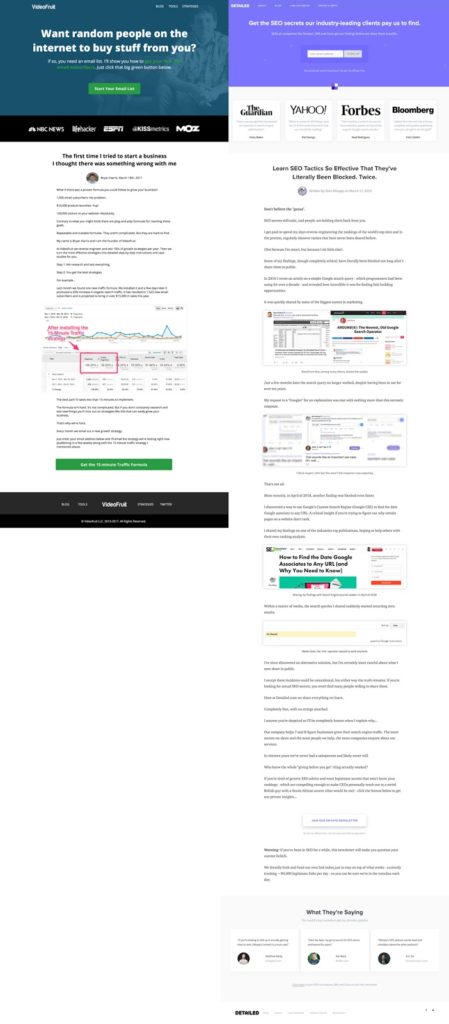In this post, you’re going to learn exactly how to build an email list using a proven system we’ve tested across hundreds of industries and types of businesses.
Over the last 5 years, we’ve used this system to not only build our own email list of 300,000+ subscribers but also to help hundreds of businesses get their first 1,000+ subscribers.
Most email list-building posts give you a big, long list of tactics with step-by-step instructions and case studies that show you how to implement them.
But the truth is, you need more than just tactics. In fact, I’ve found that the tactics you choose to build your email list will be among the least important factors in your success or failure.
Think of tactics like the “sweets” section of the food pyramid we all saw in elementary school:
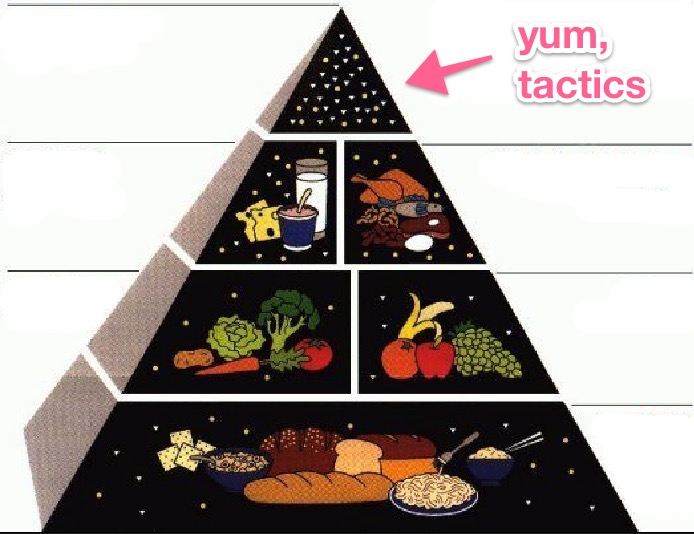
So tasty. So easy to binge on. If you and I had our choice, we’d eat tactics for breakfast, lunch, and dinner.
Unfortunately, they’re the smallest part of a balanced list-building diet.
Just ask Elena Favilli.
You’ve probably never heard of her, but Elena is one of the smartest entrepreneurs I’ve ever met. (The smartest ones always fly under the radar.)
When I met Elena, she wanted to launch a book that would empower and inspire young girls. And to make that launch successful, she knew an email list would be key.
She was already doing tons of the tactics that are supposed to help you build a list: creating great blog content, offering lead magnets on her site, hosting giveaways on Facebook, etc.
The tactics alone were enough to get her small, sporadic wins. 50 subscribers here, 20 subscribers there. But with the launch coming up soon, she needed faster growth.
When she came to us for help, it was easy to see she didn’t need more tactics… she just needed the right system around those tactics.
She needed the full list-building “food pyramid.” The unsexy stuff no one usually talks about: the veggies, the fruits, the healthy stuff.
Yes, you do need certain tactics and strategies to build an email list (and we’re going to cover those).
But it’s the system that shows you how to implement the right tactics at the right time.
The system helps you adjust when something doesn’t work.
The system keeps you from wasting time on things that don’t matter.
And the system is what helped Elena build a list of 30,000 subscribers in 13 months and launch the most crowdfunded book of all time, Good Night Stories for Rebel Girls. Her Kickstarter campaign alone brought in $675,614.
In the past, we’ve kept all that system stuff locked inside our paid courses and coaching. But over the next 8 weeks, we’re going to peel back the curtain.
We’re going to walk you step by step through every piece of our proven list-building system so you can get more email subscribers in the next 8 weeks than you did in the last 8 months.
Each week, I’m going to walk you through one part of our list-building system and give you one or two very specific tasks so you can implement them.
Psyched? Me too.
 Get it Free FREE Bonus: Want to get my single best list-building strategy without reading thousands of words? Click the button to unlock a 24-hour pass to a new 15-minute training I created on the fastest way to build your list.
Get it Free FREE Bonus: Want to get my single best list-building strategy without reading thousands of words? Click the button to unlock a 24-hour pass to a new 15-minute training I created on the fastest way to build your list.
The 5-Part List-Building System
-
- Part 1: Strategy — You’ll see the 3 steps that will ensure you pick the right strategies for growing your list so you can avoid wasting months of time on stuff that doesn’t work. (This is also the key to avoiding shiny-object syndrome.)
-
- Part 2: How-To — You’ll get our Top 15 Recommended List-Building Strategies (with step-by-step walkthroughs) so you can create a roadmap to hit your list-building goal.
-
- Part 3: Accountability — Consistent, focused action is probably the most overlooked ingredient in successfully growing an email list. We’ll show you how to bake it into your schedule so you stay on track.
- Part 4: Adjustments — Even perfect plans don’t stay perfect forever. We’ll give you our system for evaluating your list-building progress and making the right adjustments so failed experiments or stalled growth don’t slow you down.
-
- Part 5: Fast Forwards — Yes, there really are shortcuts available to anyone building an email list. (We call them fast forwards.) The challenge? They’re different for everyone and highly dependent on your unique situation. Part 5 will show you how to uncover them and accelerate your progress.
Strategy. How-To. Accountability. Adjustments. Fast Forwards.
That’s the 5-part system we see get results for people over and over again. Let’s start with Part 1.
Note: Want to skyrocket your revenue over the next 90 days? Book a complimentary strategy call with one of our certified coaches.
Editor’s Note: This post was originally published on 8/5/19 and updated on 11/10/21.
Part 1: Strategy — 3 Critical Steps That Will Set You Up for List-Building Success
This section will walk you through 3 easy steps you should take before trying to implement a single list-building tactic.
Think of them as “Miyagi exercises.”
If you’ve ever seen The Karate Kid, you know Mr. Miyagi doesn’t just show Daniel a bunch of super cool kicks and ninja moves on Day 1.
Instead, Mr. Miyagi has him wax his cars (“wax on, wax off”) and paint his fence—activities that seem kind of pointless to Daniel, but end up being the perfect preparation once it’s time to actually fight.
Fortunately, the Miyagi exercises I’m about to show you only take about 5 minutes to implement instead of half a movie.
The result, however, will be the same: you’ll avoid implementing the wrong tactics and start getting big email marketing wins MUCH faster than you have in the past.
Ready? Let’s go!
1232333993223Step 1: Set the Right Kind of Goal with Our Dead-Simple Framework
When people decide to get serious about growing an email list, one of the first questions they spend WAY too much time thinking about is this:
“How many email subscribers do I need in order to ________________ ?”
That blank is filled with the typical reason people start focusing on list-building in the first place:
-
- Have a profitable product launch
-
- Start getting better clients
- Generate more sales
The problem with this question is that it will almost always lead you to one of two bad outcomes:
Bad Outcome #1: You’ll set an impossibly ambitious goal, get discouraged, and burn out.
Bad Outcome #2: You’ll get analysis paralysis and end up setting no goal at all.
So here’s the dead-simple, one-question framework we created for setting a rock-solid list-building goal in about 2 seconds:
Which of the following numbers of subscribers is your email list closest to?
-
- 100 subscribers
- 1,000 subscribers
- 10,000 subscribers
Pick the number you’re closest to but haven’t hit yet, and boom—you’ve got your goal.
That means if you’re starting from scratch, your goal is 100 subscribers.
If you have 300 subscribers, your goal is 1,000 subscribers.
If you have 1,500 subscribers, your goal is 10,000 subscribers.
Why those three numbers? Two reasons:
- We’ve found over and over again that these numbers are powerful inflection points for confidence and building momentum. When you get to 100 subscribers, getting to 1,000 subscribers suddenly seems much more attainable. When you get to 1,000, believing you can get to 10,000 becomes much easier. And when you get to 10,000, pretty much anything will feel possible.
Set the closest goal first. Once you hit it, shooting for the stars will be a whole lot easier.
- You don’t need nearly as many subscribers to start generating meaningful revenue as you probably think. To some, setting a goal of 100 or 1,000 subscribers will feel like it’s not big enough. You couldn’t possibly have a successful product launch or increase your income with a list that small, right?
That’s when I point to people like John Meese.
John built a list of 249 subscribers in 45 days and launched a course that brought in $10,541 in sales.
You do not need a ginormous list in order to create a ginormous impact for yourself and your business.
And look, feel free to get a little flexible. If you have 900 subscribers and want to go ahead and shoot for 10,000 instead of 1,000, go for it.
Regardless of which goal you choose, here is your first action item:
Put that goal somewhere you will see it every single day.
The easiest way to do that is with our free tool List Goal. It turns the “New Tab” screen on your web browser into a list-building command center customized with your goal, like this:
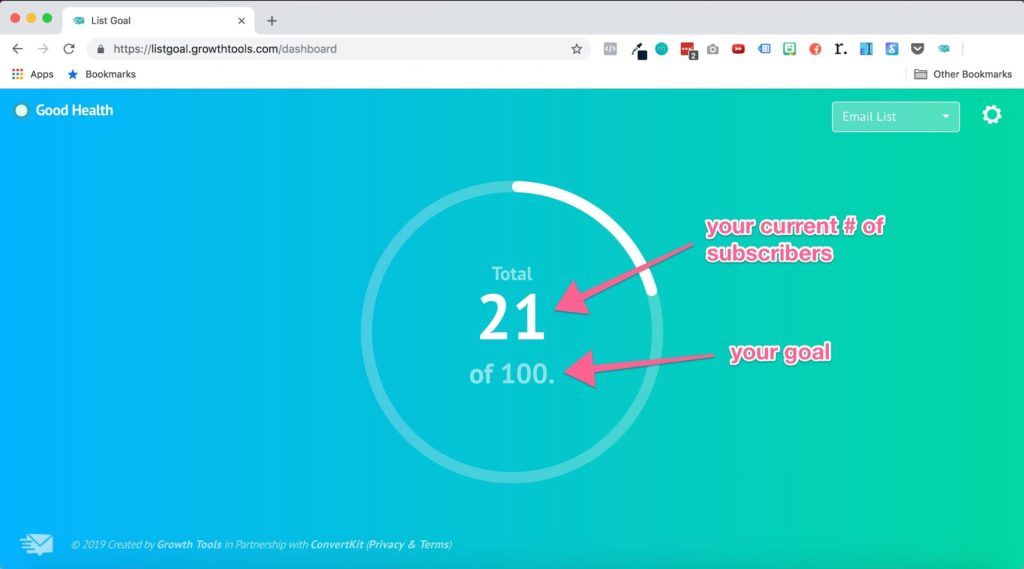
As you can see, List Goal also automatically shows you the progress you’ve made toward your goal.
It sounds small, but having your goal somewhere you’ll see it regularly is one of the most effective things you can do to make sure you’re taking small steps every single day to make progress.
Go here to get List Goal free now.
Step 2: Identify Your List-Building Strengths
Over the last year, I built a playground thing for our kids in the backyard. It was a blast.
I had to look up how to make a few different parts of it, but for the most part, I stuck to skills and tools that I’m already comfortable with.
But my YouTube search history tells a different story.
I watched all kinds of crazy advanced stuff that I would NEVER attempt to do with my current skills and available time. Like this video on how to build your own lazy river:

Going down rabbit holes like this is fun with hobbies.
But when you’re trying to build or scale an online business, this is the kind of thing that ends up being a HUGE drain on your time and energy. Yet I see people do it all the time:
- They spend hours reading a crazy case study about someone who makes $50,000/month from Facebook ads… even though they don’t have the budget to invest in paid ads right now.
- They spend weeks trying to A/B split test every headline on their site even though they barely get 100 website visitors per month.
- They spend months trying to line up guest blogging opportunities even though they hate writing and aren’t particularly good at it in the first place.
And then they wonder why they aren’t making any significant progress on growing their list, even though they feel so busy.
Listen: there are too many effective marketing strategies for you to spend time focusing on ones you hate or are not equipped to implement.
Instead, take 5 minutes to determine which strengths you already have (or would be excited to work on) and which resources are already available to you.
Here is a list and description of the main ones that help with list-building. Write down the ones you already have or that you could see yourself enjoying. This will help you pick strategies you will actually enjoy when the time comes.
Strengths That Help with List-Building:
-
- Writing: I’m not asking if you have what it takes to be a bestselling author. I never thought of myself as a “writer” before I started Videofruit, yet I wrote a blog post every week for 2+ years. Could you see yourself enjoying blogging? Does the idea of having an audience of people reading things you write excite you? Is it something you already do? Put writing down as a skill you might enjoy developing.
-
- Talking: Do you enjoy conversations? Does getting in front of a camera or appearing on a podcast sound exciting to you? Could you see yourself wanting to speak at a conference? Mark yourself down as a talker. Because it’s about to come in handy big time.
-
- Tech Stuff: Are you good at figuring out how to use new software tools? Do terms like “marketing funnels” and “segmentation” and “WordPress integration” get you all hot and bothered? Do you geek out over numbers? You’re probably good at tech stuff, you nerd. Write it down.
-
- Relationship-Building: Do you like meeting new people? Are you unafraid of striking up conversations? If we were in the ‘80s right now, would you have a giant Rolodex sitting on your desk? You’re a relationship builder.
- Teaching: Do you like walking people through processes? Does it feel rewarding to show someone how to do something? Are you already pretty knowledgeable about the topic your email list is about? You’ll probably like teaching.
- Relationship-Building: Do you like meeting new people? Are you unafraid of striking up conversations? If we were in the ‘80s right now, would you have a giant Rolodex sitting on your desk? You’re a relationship builder.
Resources That Help with List-Building:
-
- Money: Do you have an existing marketing budget? Are you at a place where you can afford to invest in something like Facebook ads and be OK if they’re not instantly profitable?
-
- Traffic: Do you have a website or social platform that’s already getting traffic? If so, write down a rough estimate of your average monthly visitors. Just ballpark it.
-
- Existing Subscribers: Pretty straightforward. Do you already have existing email subscribers? I’m going to show you several ways to leverage them to grow your list faster. Put them down as a resource.
-
- Relationships: Do you have an established relationship or social connection to any businesses, influencers, or companies in your industry?
- Time: How much time do you have per day or week to focus on growing your email list? Again, just ballpark this. Even if it’s just 15 minutes per day, write it down.
At the very least, you should have at least one strength you’re interested in developing and some amount of time available in the “Resources” section.
Knowing this info is going to save you a TON of grief. But if you combine it with one more step, you will practically guarantee yourself a head start.
Step 3: Use the ICE Framework to Pick the Right Strategies and Avoid “Shiny Object Syndrome”
Most email marketing strategies will fall into at least one of the following three categories:
-
- Stuff you like to do
- Stuff you have the resources to do
- Stuff that gets results
Everything we covered in Step 2 will help you with the first two categories. But the key is to pick a strategy that will satisfy all three. Think of it like this:
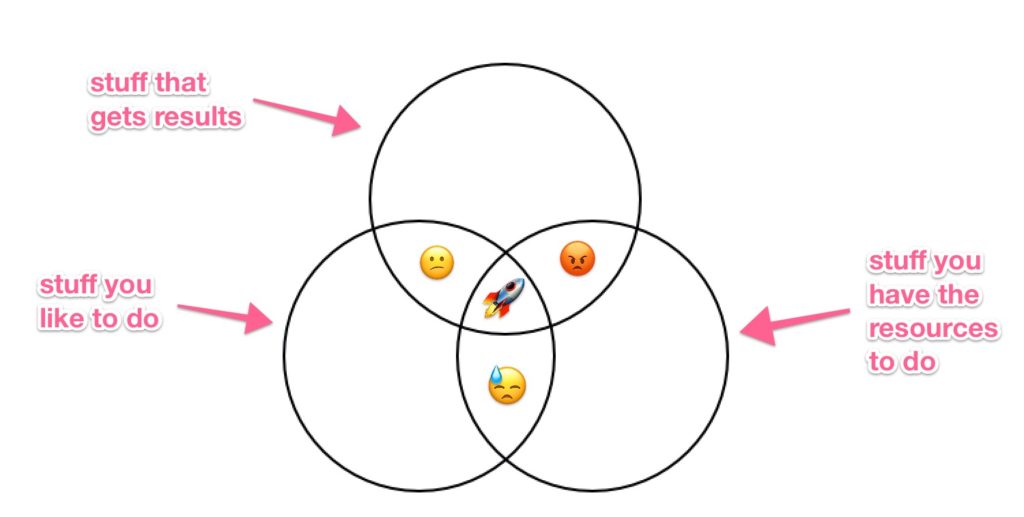
See that sweet spot in the middle? When you start consistently implementing strategies that fall into all 3 categories, your list growth will take off.
You won’t get burned out. You won’t get distracted. You won’t waste time on stuff that doesn’t move the needle.
How do you figure out which strategies will hit the sweet spot? You use the ICE Framework.
The ICE Framework forces you to ask three questions about any potential list-building strategy before you take the time to implement it:
-
- Impact: How impactful could this strategy be for my list growth?
- Confidence: How confident am I that this strategy would draw in potential customers?
- Ease: Given my skills and resources, how easy would it be to implement this strategy?
You score each question 1 to 10 (with 10 being the highest impact, highest confidence, and highest ease), total the scores, and boom: you’ve got your ICE score for a particular strategy.
The ICE Framework isn’t something I just made up, and that’s part of the beauty. People have used it for years in tons of different contexts where they need to choose between multiple potentially effective options.
For example, let’s say I wanted to lose 10 pounds. Right off the bat, there are going to be literally hundreds of things I could do to accomplish that goal. How do I decide what to try first? I pick a few options and ICE them:
Option #1: Running 2 Miles Per Day
-
- Impact: I might need to make a few tweaks to my diet to speed things up, but on its own running is still pretty likely to eventually get me to my goal. I’ll give it a 7.
-
- Confidence: It’s been a few years since I’ve gone for runs consistently, but with a little conditioning I know I can do it. Let’s say 8.
- Ease: My neighborhood is convenient for running, but I’m not sure what I would do if it’s raining. I guess I’d have to drive to an indoor track or something? That would be a pain. I’ll give this a 6.
ICE Score: 21
Option #2: Stop Drinking Soft Drinks
-
- Impact: I know tons of people this has made a huge difference for. I give it a 10.
-
- Confidence: I’ll probably slip up here and there, but as long as I get them out of the house I should be able to stick to it. Let’s go 7.
- Ease: I just need to replace the Cokes in the fridge with fizzy water. Pretty easy—8.
ICE Score: 25
Within a minute, I have a clear-cut decision that I know is likely to work for me. No need to run 2 miles every day—I’ll just stop drinking Coke.
ICE works exactly the same with list-building strategies, regardless of your industry, business type, or where you’re starting.
That’s why we put together an ICE Framework for List-Building spreadsheet freebie you can copy and use, right here.
Here’s an example of what it looks like filled out for two different types of businesses, with very different list-building skills and resources:
Example #1: Johnny the Online Course Creator
Johnny is building an email list so he can have a warm audience of buyers when he launches his online course on canoe building.
He LOVES talking about canoe building and has hosted a few in-person workshops over the years, so talking is definitely his strongest skill. He has a blog he occasionally updates, but he has difficulty making time to write and doesn’t feel super confident in his writing.
The business is still pretty new and isn’t generating revenue yet, so he doesn’t want to invest in any list-building strategies that require cash right now.
Johnny narrows down his options to 3 strategies that sound promising: partner webinars, a podcast tour, and expanded guest posting. He plugs them into the ICE Framework like this:

Boom! Johnny now has a clear path forward: a podcast tour is right in the sweet spot of impact, confidence, and ease, while also aligning well with his skills and resources. With a 22, partner webinars also seem like a promising strategy. He’ll make that his next list-building experiment after seeing how podcasts go.
Example #2: Susie the Marketing Agency Owner
Susie, on the other hand, has a totally different business and set of skills and resources than Johnny.
She runs a small marketing agency with a virtual assistant and two contractors. She has a decent pool of clients, but wants to build a bigger audience for her blog so she can attract better ones more consistently.
She’s good at creating content and enjoys writing detailed blog posts. She’s also built up several good relationships with known influencers in the online marketing space through her client work. Currently, her email list is at 650 subscribers and her blog gets roughly 1,000 visitors per month.
She’s considering three different list-building strategies, so she plugs them into the ICE Framework:

Again, there are two clear winners. While putting together a virtual summit has off-the-charts potential for lead generation, it would require WAY more work than adding content upgrades to her blog or running a giveaway. Susie can start with those strategies, evaluate the results, and then decide if she wants to invest the time to organize a virtual summit.
Part 2: How-To: Our Top 15 Recommended Email List-Building Strategies
At this point, you know the 3-step process for picking the right list-building strategies for your business.
Next, I’m unveiling our top 15 recommended list-building strategies so you can apply that process and discover the exact strategies that will help you get your first (or next) 1,000 subscribers.
Here are Your Action Items:
- Skim through these 15 strategies and take note of the ones that seem interesting to you. (You don’t need to read them all word for word right now. Just check out the ones that catch your eye.)
- Apply the ICE Framework (which we covered in Part 1 of this post) to the top 2 or 3 strategies that you think might work best for you.
- Leave a comment with the strategy that has the highest ICE score for you and tell me why you’re excited about implementing it.
In the next 15-20 minutes, you’ll have a complete roadmap of the strategies you’ll implement over the next few weeks.
Feel free to use this Table of Contents to go directly to any strategy that sounds interesting to you:
- 1. Jump-Start a Brand-New Email List with Ambassador List-Building
- 2. Use “Guest Emailing” to Get Promoted for Free to Other People’s Email Lists
- 3. “Expand” Your Next Guest Post and Get 10x More Subscribers
- 4. Get Your Content Shared Automatically with Viral Thank-You Pages
- 5. Turn Email Subscribers into Instant Word-of-Mouth with a Viral Email Campaign
- 6. Get Major Companies and Influencers to Promote You to Their Audiences with the Poster Boy Formula
- 7. Tweak Your Homepage and Convert 86% More Visitors into Email Subscribers
- 8. Convert 20% of Blog Readers into Email Subscribers with Content Upgrades
- 9. Double the Effectiveness of Partner Webinars with One-Click Opt-Ins
- 10. Spike Your Organic Blog Traffic with This Basic SEO Checklist (for Non-SEO People)
- 11. Get Interviewed on Top Podcasts in Your Niche
- 12. Bring in a Windfall of Subscribers with a Giveaway
- 13. Get Dirt Cheap Leads from Facebook with the “Reverse Facebook Ad” Framework
- 14. Be the Bonus for Someone Else’s Launch or Promotion
- 15. Organize a Virtual Summit and get 10,000+ Subscribers
1. Jump-Start a Brand-New Email List with Ambassador List-Building
One of the most frustrating things with general email list-building advice is that so little of it applies to people who are just getting started.
If you just launched your website and email list yesterday, tactics like adding exit intent pop-up forms or optimizing your blog posts for signups aren’t going to move the needle for you yet.
That’s why we always recommend Ambassador List-Building as the very first strategy anyone starting an email list should implement (although it also can still work well if you’ve been building your list for a while).
You don’t need existing traffic. You don’t need existing email subscribers. And Ambassador List-Building can still easily get you around 250 subscribers (or more).
So, what is it? Ambassador List-Building is simply inviting everyone you already know to join your email list.
(Trust me, if you think you’ve already done that—you haven’t in the way I’m about to show you.)
Here’s how Ambassador List-Building works:
Step #1: Make your 4F list.
The first step is to make the list of people you’re going to personally invite to sign up for your list. They will each fall into 1 of 4 groups that all start with the letter F, hence the name 4F List:
Group #1 is Your Followers.
These are the people who follow you on any online platform where you have an active account (Facebook, Twitter, LinkedIn, etc.).
For example, I never use LinkedIn but somehow have over 900 connections there. I reached out to all 900 via email and personally invited them to join my list. (You’ll see what to write in this kind of email in the next section.)
Out of those 900 connections, 83 signed up. After I followed up with everyone who didn’t join or respond, 32 more people subscribed. That’s 115 new subscribers in less than 24 hours.
Group #2 is Your Former Customers and Vendors.
These are people you’ve done business with before.
For example, if you’re a freelancer, you should absolutely invite all of your former clients to join your list (and your current customers too). If you have subscriptions to software products, invite the salespeople who sold you those products to join your list.
Group #3 is Your Future Customers.
These are people you’ve met at conferences, events, networking meetups, etc., or exchanged messages within online communities.
For example, you can open your desk drawer and find every business card you’ve been given. Invite every one of those people to join your list.
Look through any LinkedIn, Slack, or Facebook communities you’re in and personally invite individual members you’ve connected with to join.
Look back through your calendar for any meeting you’ve had in the past few years. Invite the people you met to join your list.
Group #4 is your Friends and Family.
If you’re just starting out, you might not have that many people to reach out to in Groups 1, 2, or 3.
But don’t discount the value that can come from getting your friends and family to join your list.
They are low-hanging fruit that can share your content and website and help you get your work/business in front of more people early on.
Recently at a live workshop we hosted, a guy named Dominic invited all of his friends, family, neighbors, and coworkers to sign up for his list over the course of the 8 hours we spent together. By the end of those 8 hours, he already had 100 new subscribers.
Step #2: Invite your 4F list to subscribe.
Once you’ve finished making your 4F List, you should have 100 to 1,000 people to invite.
Listen, because this part is important:
Do NOT send group emails, broadcast invites, Facebook posts, tweets, or any type of message that goes to more than 1 person when inviting your 4F List to subscribe.
When you ask a large group of people to do something, very few people will do it because everyone will assume that someone else in the group will do it. This is known as the Law of Big Crowds.
However, if you ask each member of that exact same group individually, almost every person will take action.
So, as you work through your list of people to invite, take your time, go 1 by 1, and send a personal message to each person asking them to join. It doesn’t matter if it’s an email, a text message, a Facebook message, an Instagram DM, etc. Just make sure it’s a 1:1 personal message.
These messages do not need to be long or complicated. Here are 2 scripts you can use to quickly create your own. Just be sure to add in your own language and make them feel personal.
Script for Inviting People to Join a Brand-New List:
Hey FIRSTNAME, I’m starting a newsletter where I talk about TOPIC. Thought you might enjoy following along on my journey. Want in?
Script for Inviting People to Join an Established List:
Hey FIRSTNAME, Not sure if you know, but I write a weekly newsletter about TOPIC. I think it’s something you’d enjoy following. Want in?
Notice how there’s not a link to a sign-up page or anything that seems like a marketing CTA. Give each person the opportunity to tell you yes or no.
In fact, when people respond with a yes, the best way to get them to follow up on their commitment is to simply reply with, “What’s your best email?” and then manually add them to your list when they send it.
You will almost always get more emails this way than if you send them to an email signup form after they tell you yes.
Step #3: Ask new subscribers for a referral.
Steps 1 and 2 alone can add 100s of subscribers to your list.
But adding in Step 3 can get you an additional 20-30% more subscribers with very little effort.
It’s where the “Ambassador” aspect of the strategy kicks in. The goal is to get each person who signed up to invite 1 other person to join.
How do you do that without sounding awkward?
Easy: as soon as someone confirms they’ll sign up, thank them and ask if they know 1 other person who might be interested in joining.
For example, when my uncle joined my list I responded with…
“Awesome, thanks! Do you know 1 other person that would be interested in growing their business too?”
He responded with, “Yeah, actually, my friend Mike runs a small print shop and he would. His email is…”
I then reached out to Mike and made a quick reference to my uncle and he became a subscriber. (This part is important. Do not just add someone to your email list because a friend of theirs told you they might like it. That is spam, and it will get you in trouble.)
You should implement this strategy if:
- You have a brand-new email list and not many resources like existing traffic, existing subscribers, etc.
- You have an existing email list but have never reached out to your network to promote it in a highly personal 1:1 way.
As I mentioned earlier, we typically see people add 250+ subscribers to their email list in less than a week when they follow these 3 steps to Ambassador List-Building.
2. Use “Guest Emailing” to Get Promoted for Free to Other People’s Email Lists
Guest emailing is one of those strategies that somehow continues to fly under the radar even though it can have a major impact on your list growth.
It gets 1/10 the fanfare of guest blogging, but I’ve often found that it can be 10x as effective.
Here’s how it works at a high level:
- Step #1: Find someone with an audience or customer base similar to yours.
- Step #2: Ask them to email your lead magnet (or webinar, free ebook, resource guide, etc.) to their audience.
- Step #3: In exchange, offer to email one of their lead magnets (or webinar, white paper, resource guide, etc.) to your audience.
Even if you have a small list (or you’re not super well known), you can still grab big chunks of new subscribers with guest emailing.
Quick case study:
One of our Growth University students, Alp Turan, runs a marketing blog. He got a software start-up in the same space to partner up with him on a guest emailing campaign. 312 people ended up subscribing to his list in less than 48 hours.
Here’s how you can do the same thing, step by step:
Step #1: Identify potential partners.
Your guest emailing partner should be in a similar or a shoulder niche. A shoulder niche is something related to your site or business’s main topic, but not a direct match.
For example, if you’re a freelance designer, a web developer, or a copywriter would work.
Next, you’ll look at the size.
Partners who are either your size or smaller are going to be the best ones to pursue for Guest Emailing, which is a big reason why this strategy can work even if it’s your first time building a list.
Even if your partner only has 500 subscribers, you can still expect to add 50+ to your list.
Step #2: Pitch the partner (with this exact email script).
When you’ve found the right partner, instead of instantly asking them to promote your lead magnet, start by looking at the content they have that you could promote to your list.
When you find something you genuinely like (and you think would interest your audience), it’s time to reach out to be the partner.
Here’s an email script based on what we’ve seen work with our own guest emailing partnerships:
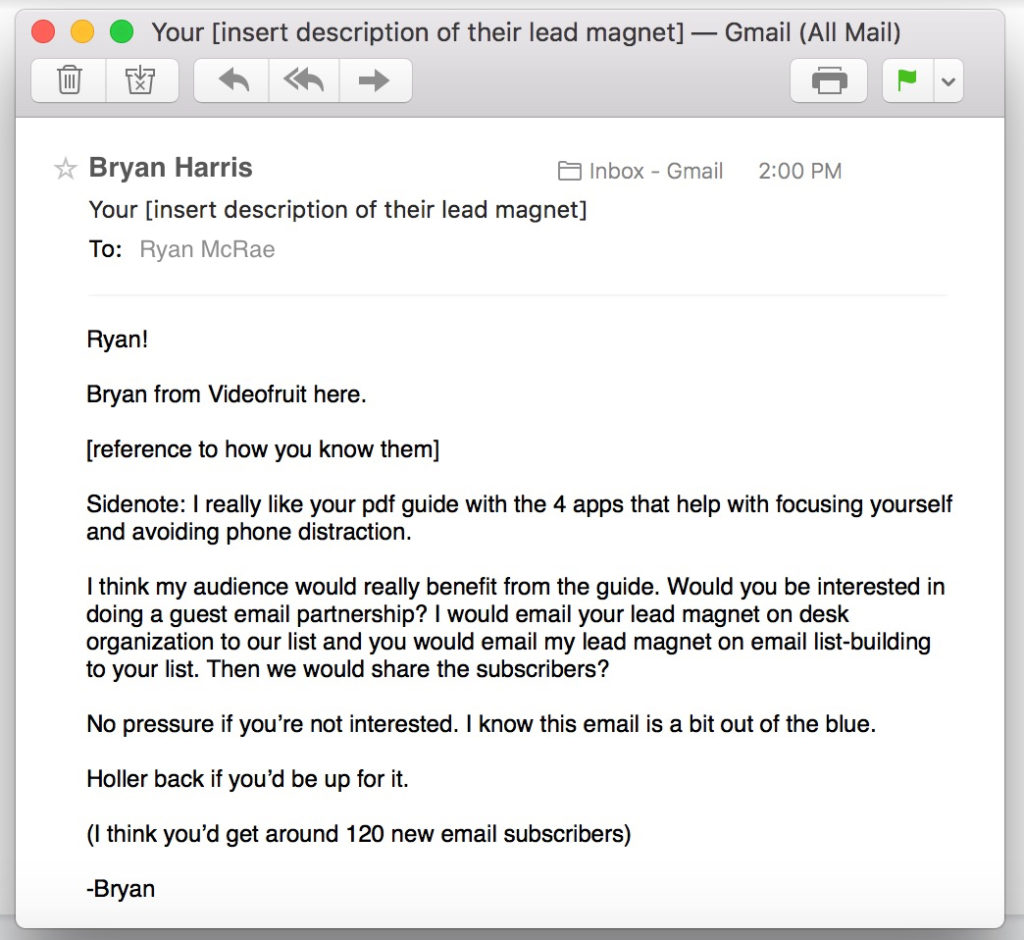
Notice that this script tells the prospective partner you want to promote their lead magnet BEFORE it asks them to promote yours in return.
Offer to give before you ask.
Step #3: Swap and deliver lead magnets.
To execute the swap, I recommend drafting the email body and subject line your partner will send to their list for them.
It’s fine if they want to make tweaks, but giving them a pre-written draft will make the process way easier on them and guarantee that the email is as effective as possible.
The structure I recommend is super simple, and you should be able to put it together in under 30 minutes. Here’s the template we typically use:
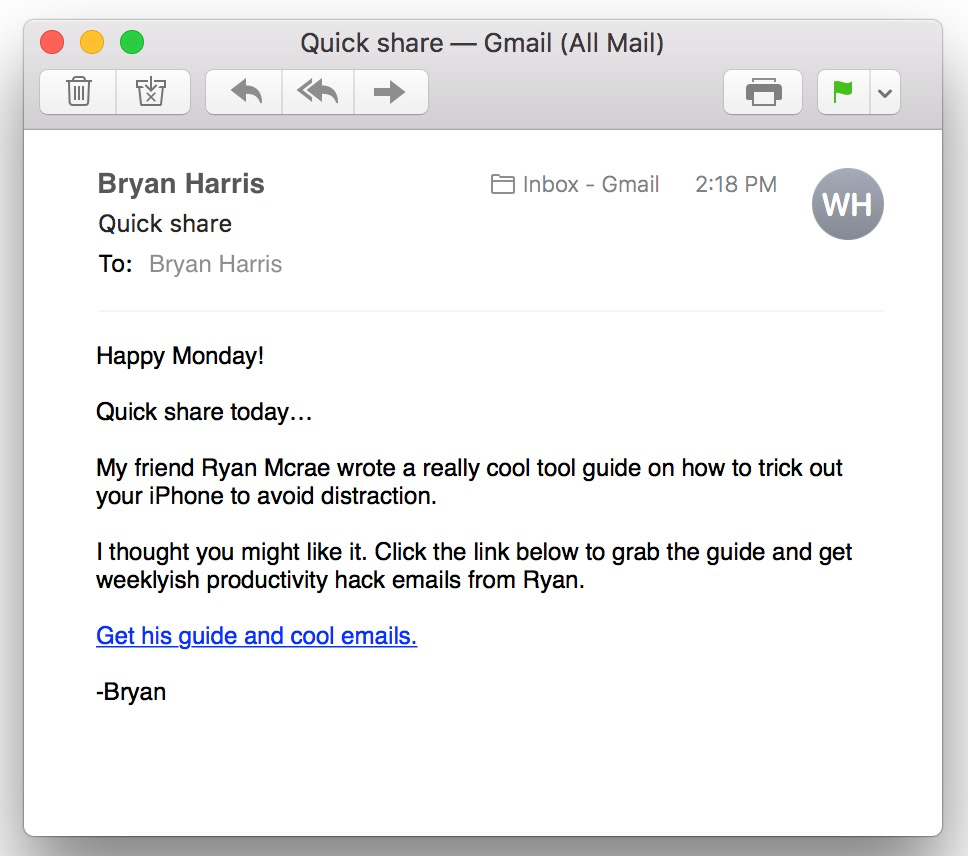
Simple and to the point, right? It might seem too basic, but we’ve found keeping it short and sweet leads to more clicks and subscribers.
You can use the same template to write the email you’ll send to your list about your partner’s lead magnet as well.
You should implement this strategy if:
- You have a lead magnet, white paper, resource guide, etc. that a partner could promote to their list. (And if you don’t have one, you can easily create your first with our free lead magnet creator tool, Attract.)
- You have at least 100 subscribers to promote your partner’s lead magnet to. (Note: This can also work if you have an audience on a platform like Facebook, Twitter, Instagram, YouTube, etc. Don’t hesitate to offer to promote a partner’s lead magnet on another channel besides email.)
Here are the typical results you can expect from a guest emailing partnership based on your list size:
- If you have an email list of 100, you can expect to add 10-20 subscribers.
- If you have 1,000 subscribers, you can expect to add 80-90 new subscribers.
- If you have 10,000+ subscribers, you can expect to add 500-1,500 new subscribers.
Like I mentioned earlier, we almost always recommend that you try guest emailing before guest posting. It requires much less effort since you don’t have to write an entirely new blog post specifically for someone else’s audience from scratch.
That said, guest posting can still be highly effective as long as you do one very important thing in your guest post’s CTA…
3. “Expand” Your Next Guest Post and Get 10x More Subscribers
There are very few things more frustrating than putting weeks of work into pitching dozens of guest post ideas, finally landing one, putting in even more work to write the post, and then…
…getting a measly 15 new email subscribers as a result.
If that sounds weirdly specific, it’s because that’s exactly what happened to me back in 2014 when I landed a guest post on the KISSmetrics blog, which had a massive audience at the time!
Soul crushing. This is why I decided to do something dramatically different for my next guest post.
The results? 503 new subscribers within a week of the post going live.

What did I do differently?
I used the Expanded Guest Post strategy.
To understand how the Expanded Guest Post works, let’s think about what usually goes wrong with guest posts: the call to action.
The CTA in a guest post typically looks something like this:
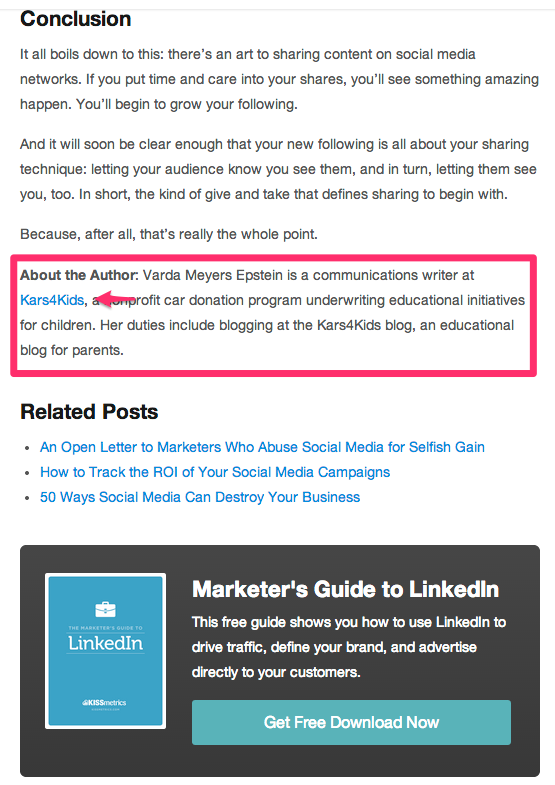
A tiny “About the Author” section with a single link to your site that’s crammed between a bunch of other CTAs that aren’t related to you.
The problem with a traditional guest post is the conversation stops at the last sentence. There is no compelling call to action and no incentive for potential new customers to start getting emails from you.
An Expanded Guest Post extends the conversation by incorporating a CTA that ties directly into your post’s content and delivers on suspense you’ve built up throughout the post.
Compare that generic “About the Author” section to the CTA I created for the guest post that brought in 503 subscribers:
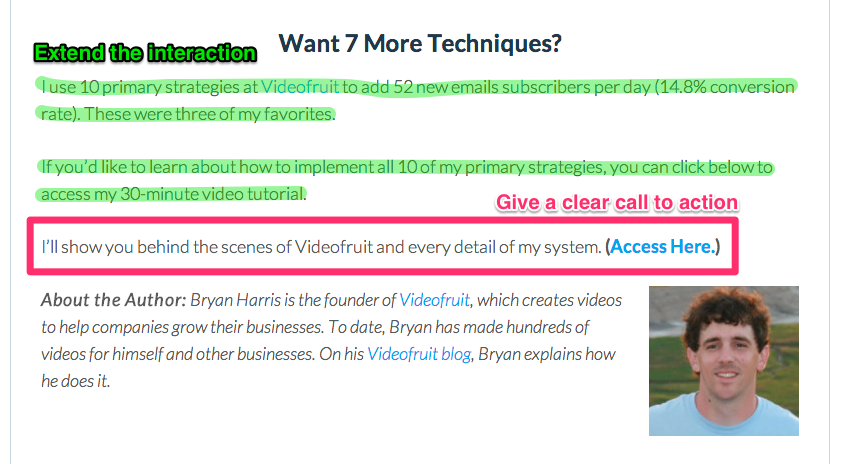
Notice how the CTA from my expanded guest post EXPANDS (wink, wink) on the post’s content. The post taught readers 3 of my best list-building techniques. The CTA offers a content upgrade that covers 7 more.
There are just 2 things you need to be sure to do in the post before inserting this kind of CTA:
Thing #1: Make sure the post includes your very best content.
In the previous example, I covered 3 list-building techniques in the guest post and then included 7 more in the content upgrade. But the 3 I covered in the post were so valuable and in-depth, it didn’t make readers feel like I was holding out on them.
Play your best cards in the guest post. There’s no better way to convince new readers they should become a subscriber.
Thing #2: Let readers know your bonus resource is coming early on in the post.
You don’t want to bet on everyone reading your entire post. So give readers a hint in advance that you’re going to offer something valuable at the end.
For example, here’s what I put to build expectation into the intro of my expanded guest post:
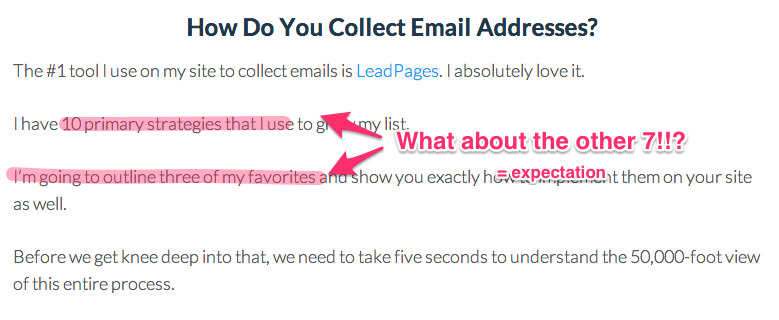
You can also explicitly state that you’re going to offer them a free bonus resource like I did in another expanded guest post I wrote for Jon Acuff’s blog:
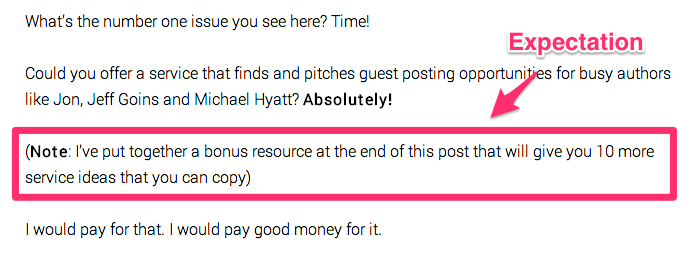
If you want an in-depth look at how to write the actual content for your expanded guest post, check out this post for a step-by-step walkthrough.
You should implement this strategy if:
- You can secure a guest post on a website that gets significantly more traffic than yours. (Since guest posting is high-effort, I’ve usually found you can get better results from smaller sites by guest emailing instead of guest posting, although there can certainly be exceptions to the rule.)
- You really enjoy writing. The effectiveness of a guest post is first and foremost dependent on the quality of its content. It needs to be really freaking good.
4. Generate Social Shares Automatically with Viral Thank-You Pages
Right now, when someone opts in for a lead magnet on your site, you’re probably sending them to a generic thank-you page like this:
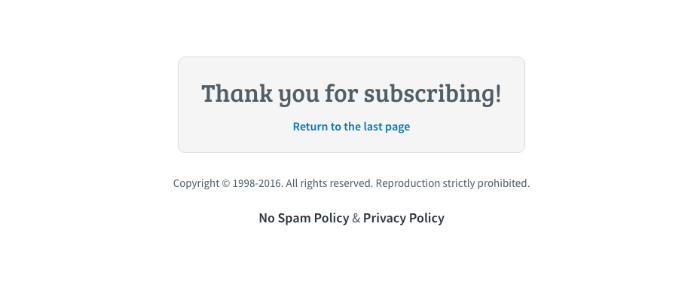
When you stop and think about the person who is landing on this kind of generic thank-you page, you’ll realize that it’s missing a HUGE opportunity to grow your email list.
Anyone who lands on your thank you page is VERY interested in you. They are so interested they just gave you permission to send them more emails. That means this is the perfect moment to ask them to take additional action that will help you.
So why not ask them to tell their friends about your site/business?
That’s exactly what the Viral Thank-You Page is designed to do. Except it doesn’t just ask them to spread the word about your site—it incentivizes them to do it.
Check out the Viral Thank-You Page that blogger Jeff Goins sends subscribers to after they sign up for the lead magnet he offers on his home page:
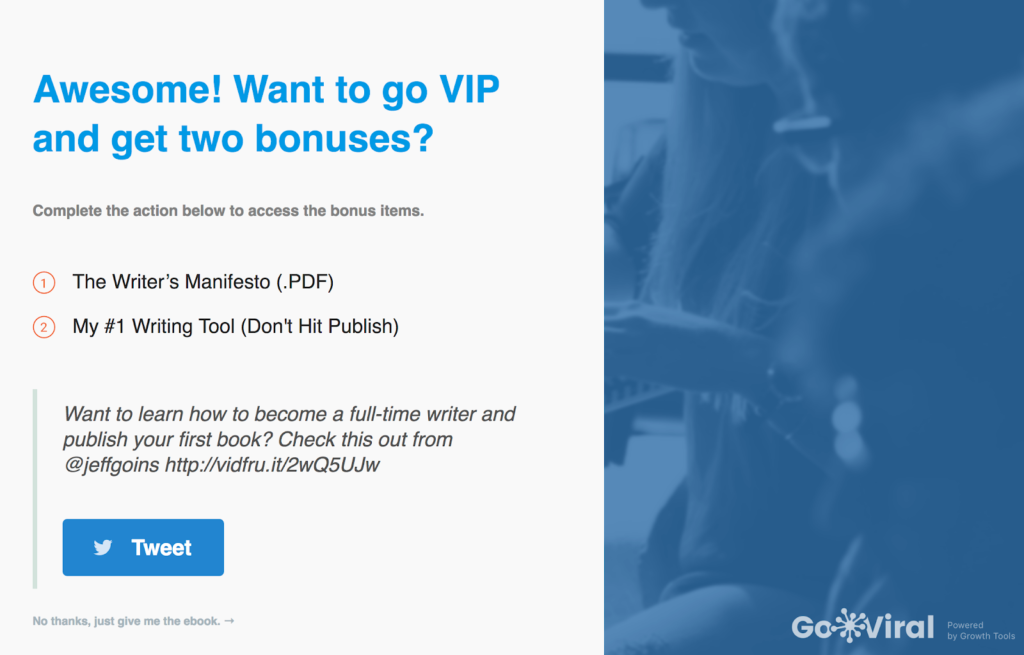
The page offers subscribers two additional bonus resources if they tweet a message that promotes the lead magnet they just signed up to receive.
The results? Jeff has gotten 7,439 people to share his website since implementing it, which has led to thousands of additional email subscribers. All because he made a slight tweak to one of his thank-you pages.
In the past, setting up these Viral Thank-You Pages was pretty difficult. That’s why we built a free tool called GoViral that allows you to set one up with just a few clicks. In fact, Jeff used GoViral to create the page you just saw in the above example.
Here’s how you can implement your own Viral Thank-You Page:
- Identify the most popular lead magnet on your site. Where do you get the most opt-ins?
- Create a simple Viral Thank-You Page with GoViral to send people to after they sign up for that lead magnet.
- Create a tweet for your visitors to share in order to unlock additional bonus resources. Include a link in that tweet that promotes the original lead magnet or something else on your website.
You should implement this strategy if:
- You’re already offering lead magnets on your website.
- You’re getting at least a handful of people who sign up for one of those lead magnets every week.
The results you get from this strategy will depend on the number of opt-ins your lead magnet is already generating, but a good rule of thumb is to expect at least 40% of those who sign up to share your tweet (though we often see people get much higher conversion rates than that).
There are few things more powerful than word of mouth, and this strategy generates it for you automatically.
5. Turn Email Subscribers into Instant Word-of-Mouth with a Viral Email Campaign
If you’ve ever created a lead magnet, you’ve probably had that awkward moment where you have to figure out how to promote it to your existing email subscribers.
Generally, you have 2 not-so-great options:
- You can send them to the same landing page everyone else has to go to in order to get access to the lead magnet. This is kind of a bummer for your subscribers because they then have to sign up for your email list AGAIN in order to access the lead magnet, even though they’re already on your list.
- You can just email them a link straight to the lead magnet file. This makes it convenient for your subscribers to access your lead magnet, but you don’t get anything in return.
The Viral Email Campaign gives you a third option that will actually help you build your list—you send your existing email subscribers to a GoViral page that grants them access to your new lead magnet after they share a pre-written post on social media.
This is exactly the kind of page Michael Hyatt created to promote a free PDF to his email list:
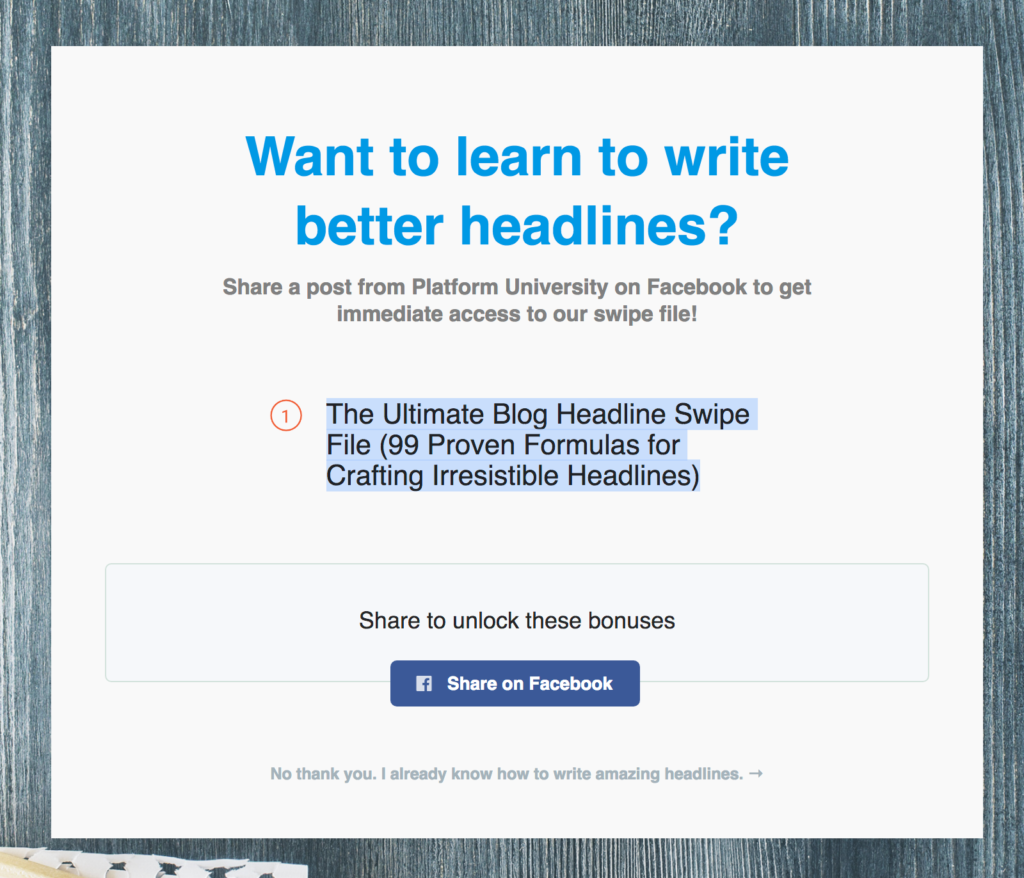
Within a few days of promoting the lead magnet to his email list, the campaign had already generated 527 Facebook shares:
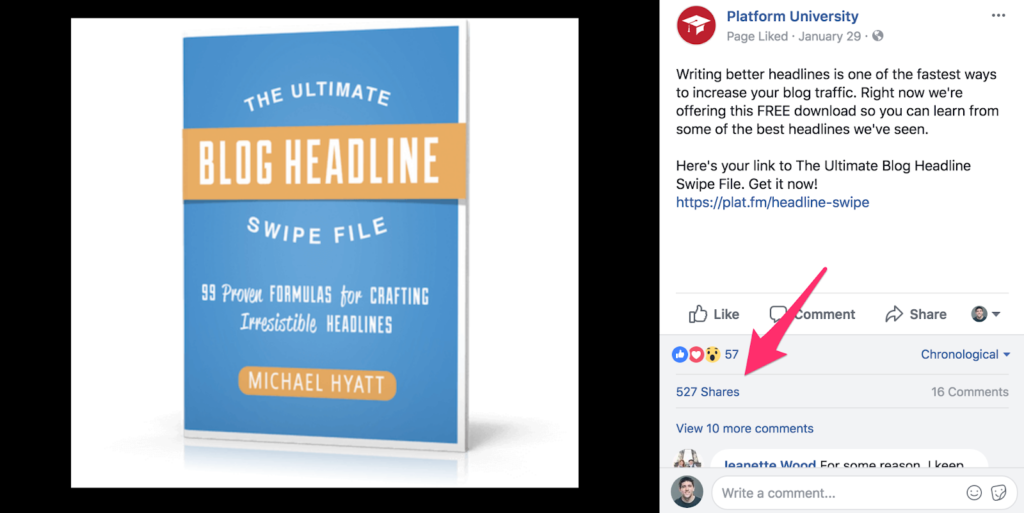
Notice how the post that people share doesn’t link to the same GoViral page that Michael sent his list to.
It links to a landing page where people have to sign up for Michael’s email list in order to get access to the lead magnet, allowing him to get new subscribers every time one of his existing subscribers shares the post.
Here’s how to implement your own Viral Email Campaign:
- Create a free resource to give away, or use an existing one that you’ve never promoted to your email list. If you need help creating that free resource, check out our free tool called Attract. You can use it to create a beautiful lead magnet in seconds.
- Create a share page for your lead magnet for free using GoViral.
- Tell your email list about the lead magnet and send them a link to your GoViral page.
You should implement this strategy if:
- You have an existing list of email subscribers. This strategy can work well even if your list is small.
- You have some type of free resource or lead magnet that you haven’t promoted to those subscribers yet.
The results you get from this strategy will depend on the number of email subscribers you have, but you can expect at least 50% of the subscribers who click through your email to share your social post.
6. Get Major Companies and Influencers to Promote You to Their Audiences with the Poster Boy Formula
When I first wrote about the Poster Boy formula back in 2014, it quickly became one of my most popular posts.
The concept was simple:
- Pick a company/influencer that has your target audience.
- Record every big or small win you get by using their product, service, or content.
- Show them the detailed info behind all of your wins and how they helped you achieve them.
- Become a success story that they happily promote to their audience, thus giving you tons of free traffic, leads, and credibility.
The original post documents how I turned myself into a success story for AppSumo that they added to the page for their flagship course and then emailed 600,000+ people about it.
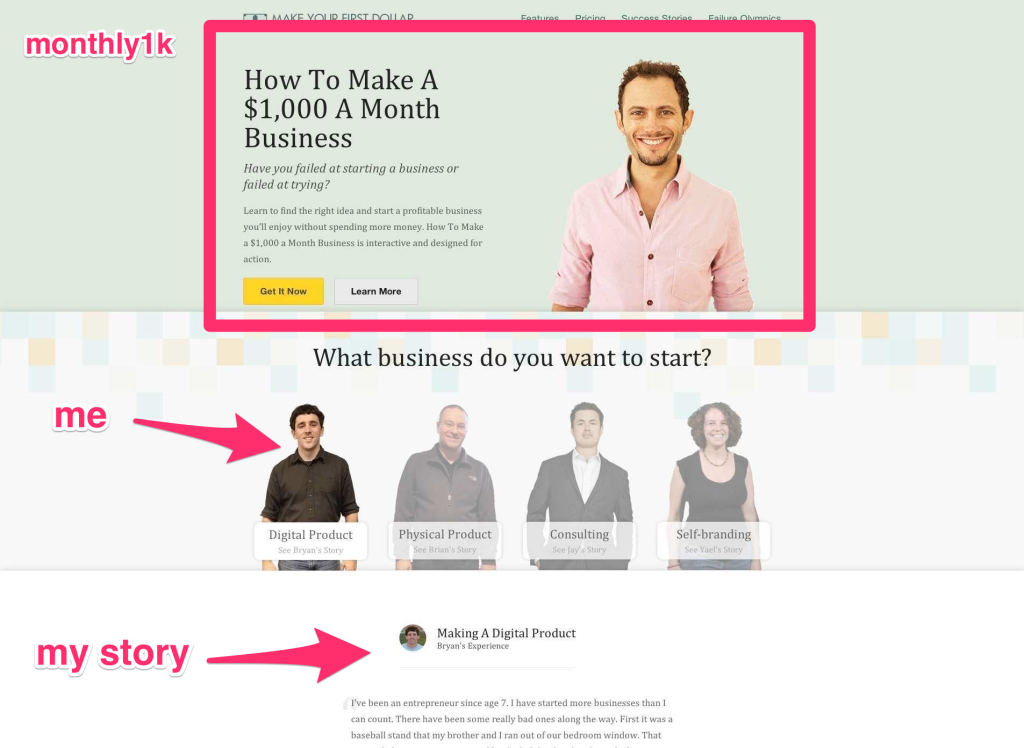
That strategy alone was how I went from zero email subscribers to over 10,000 total readers in 4 months.
But within the past couple of years, something funny started happening…
I started regularly getting emails, comments, messages, etc. from people who all had the same question: Does the Poster Boy formula still work?
I get it.
Anytime a strategy involves reaching out to influencers / big companies in your industry, it usually follows the same cycle:
- A few marketers and entrepreneurs experience incredible results with the strategy.
- A lot of people start abusing it in an annoying way.
- The strategy loses its effectiveness.
Fortunately, that has not been the case with the Poster Boy formula, for one major reason: unlike typical outreach-based strategies, it allows you to GIVE influencers reasons to promote you instead of ASKING them to promote you.
In the last year alone, I’ve seen people use the Poster Boy formula to get featured in:
- Email campaigns
- Podcasts
- Videos
- Homepages
So yes, it still works! The only thing that’s changed is we teach people a few additional steps that we’ve learned work well over the years. That’s what I want to show you today.
Step #1: Identify your Poster Boy targets.
Your first step is to identify the people or companies you could be a good Poster Boy for. Start by making a quick list of:
- Blogs or email lists you’re subscribed to
- Podcasts you listen to
- Courses or other products you’ve bought
- Books you’ve read
- Services you use
Once you’ve made your list, you want to look for people or companies that meet 2 criteria:
- They should have a significantly larger platform than you. Remember, the goal is to put yourself in a position to be promoted to a large audience.
- Their topic/audience/customer base should be directly related to yours, but they shouldn’t be a direct competitor. For example, if you’re trying to build a list about weightlifting, someone with a popular weightlifting blog might not be as likely to promote you. But someone who is a dietician might be a great fit. A good chunk of their audience is likely to be interested in weightlifting, but it’s not the blog’s focus.
Step #2: Warm up your primary targets.
Before you reach out directly to your Poster Boy targets, you need to put yourself on their radar.
By the time your first email hits their inbox, you want them to at least recognize that they’ve seen your name somewhere before.
Here are 3 quick things you can do in just a few minutes per week to warm up your targets:
- Subscribe to their newsletter and send a friendly reply to their welcome email.
In your response, don’t ask for anything. Just let them know why you’re excited about signing up and how you learned about them or their company. - Leave high-quality comments on their blog posts, podcast episodes, YouTube videos, or anywhere they publish content.
Don’t force this part with generic “Nice post!” comments. I’m talking about finding content that you genuinely like and find helpful and leaving a comment that shares why. Do it because you like the content, not because you expect anything in return.Spread your comments out over the course of a few weeks instead of leaving a ton at once and coming off like a stalker.
- Share their content on social media.
This might sound self-explanatory, but the key is to share their content in a way they’re likely to notice. To do that, praise their content in a way that’s shareable. Like this: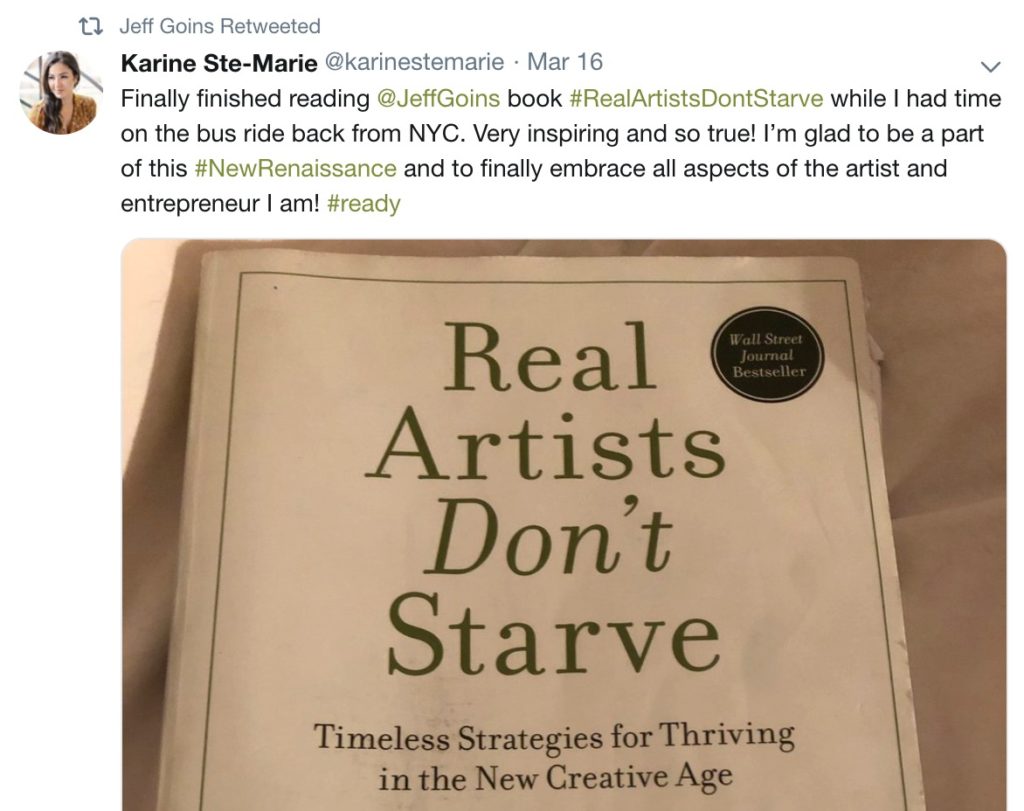
Notice how Karine compliments Jeff’s book AND mentions why she liked it. She even included a nice picture of the book along with it.
When you put thoughtfulness and effort into it, you’re 10x more likely to get on your target’s radar.
Step #3: Thank your targets and share your results.
After you’ve warmed them up, you’re going to reach out to your targets with a thank-you email that shares the results you’ve achieved thanks to them.
Important Note: These results do not need to be mind-blowing! You don’t need to have made a million dollars or won a Nobel Peace Prize in order to share an accomplishment.
The result you share can be:
- A valuable lesson you’ve learned
- A new habit you’ve been able to build
- A win you’ve had thanks to a product you bought from them
- A result you’ve gotten from taking a course they created
You can even just share that they’ve been an inspiration as you’ve made progress toward a goal you have.
Remember—you are not asking for anything with this email. You are simply sharing your results and saying thank you.
Step #4: Follow up every 90 days.
This is the most straightforward step. You’re going to follow up with each person you sent a thank-you email to every 90 days with a brief update on your progress.
You have one goal here: stay on their radar.
The reality is that your initial email isn’t likely to lead to anything beyond a nice reply. However, if you keep coming back with more in-depth details on what they’re helping you accomplish, you’re much more likely to create opportunities for yourself.
You should implement this strategy if:
- You’re currently experiencing any amount of good results thanks to someone’s product, service, or content.
- Yes, that means basically everyone should be implementing this strategy. 🙂 It only takes a few minutes of your time each week and is very easy to run in the background as you focus on implementing other strategies in this post.
Speaking of strategies that have been around for a while but still work incredibly well…
7. Tweak Your Homepage and Start Converting 86% More Visitors into Email Subscribers
Web design trends are funny.
Every 6 months, what “looks good” seems to change.
But when it comes to what converts, the opposite is often true.
Even though what looks good might change often, the design techniques and layouts that will maximize your email sign-ups tend to stay the same for long periods of time.
Case in point: it was YEARS ago that I first mentioned the “Upside-Down” homepage design that took us from averaging 150 new subscribers per week on our homepage to 280 subscribers per week.
Yet just a few months ago my buddy Glen Allsop (who runs Detailed.com and is considered one of the leading SEO experts in the world) left the following comment after he implemented the same strategy:

The key line from Glen’s comment?
“One thing is clear: I get far more email subscribers now than ever before.”
Take a look at Glen’s homepage structure next to mine and you’ll see they both closely follow the same Upside-Down structure:
Let’s zoom in on each section so you can see how it works:
Section 1: Above the Fold
This is where you’ll put the primary reason someone should join your email list. You’ll also offer your best lead magnet that helps subscribers do something related to that primary reason.
For example, on the Videofruit homepage, the headline is centered around increasing your online sales. The lead magnet helps visitors accomplish that by teaching them how to grow their email list.
Section 2: Social Proof
This section backs up the promise you make above the fold by showing visitors that you can be trusted. You can mention sites that have featured you or showcase testimonials like Glen’s site does.
Section 3: Pilot Story
If someone has scrolled past your primary CTA and your social proof, your next step is to give them a taste of your best content while also introducing yourself.
Section 4: Secondary Call to Action
Your secondary call to action can either offer a different lead magnet that’s directly related to your pilot story, or it can offer the same lead magnet as your primary CTA. Just make sure it ties into the end of your pilot story.
Section 5: Navigation
This is what makes the design upside-down. Most websites have their navigation at the very top of the page, but we found moving it to the bottom of the page increased focus and conversions.
The best part? You likely already have all of the content you need to create your own Upside-Down homepage.
You can get step-by-step instructions for putting it all together in the original blog post we wrote about this strategy right here.
You should implement this strategy if:
- Your website is getting 100 visitors or more per month.
- Your homepage isn’t converting at least 10% of visitors into email subscribers.
When you implement the Upside-Down Homepage, you can expect to start converting at least 10% of visitors into email subscribers.
When we originally made the change on our homepage, it increased the conversion rate by 86%.
Since a new subscriber is, on average, worth $20 to us, that increase translated to:
- $2,600 more every single week
- $10,400 more every month
- $124,800 more every year
Even if you only have a small amount of traffic, it can make a big difference. And it doesn’t take much time to implement when you follow the step-by-step walkthrough in this post.
8. Convert 20% of Blog Readers into Email Subscribers with Content Upgrades
Real quick, think about the most popular blog post you’ve published.
Now, ask yourself: what do you offer readers after they’re done reading it?
If you’re like most websites, it’s the same generally-related lead magnet or newsletter sign-up form you put at the bottom (or in the sidebar) of every other post.
But did you know that if you offer a lead magnet that’s specifically related to that post’s content, you could start converting as much as 20% of the people who read that post into email subscribers?
Those kinds of blog-post-specific lead magnets are called content upgrades, and they consistently get us sign-up rates as high as 20% when we offer them.
For example, in the post we published about organizing a virtual summit, we created a bonus checklist specifically designed to help readers implement the process the post teaches. We then added a CTA to download it to the post:

Creating content upgrades for your top 5 to 10 most popular posts (by traffic) is one of the easiest ways to start automatically generating more email subscribers from your blog.
In fact, when Brian Dean from Backlinko did it, the email sign-up conversion rate across his entire website increased from .54%. to 4.82% (which is a 782% increase).
After you’ve identified your most popular posts by traffic (Google Analytics makes it easy to do this), follow these 2 steps to start generating more email sign-ups from them:
Step #1: Create your content upgrade with 1 of these 4 simple templates.
This is the step that people tend to make WAY more complicated than it needs to be.
This piece of bonus content doesn’t need to be a masterpiece. It just needs to be highly relevant to the post’s topic.
We’ve found that these 4 templates are extremely easy to create and consistently work well with most types of blog posts:
- Checklist: A checklist gives readers a quick-reference version of the steps, strategies, or techniques you describe in your blog post.
- Resource Guide: A resource guide is a collection of tools, products, or links that are described in your blog post.
- How-To Guide: A how-to guide either expands on something you teach in your blog post or condenses a process down into a series of steps.
- Case Study: A case study shows off a success story from someone who implemented what your blog post teaches.
Creating these kinds of content upgrades used to be kind of a pain, so we built a simple, free tool called Attract that gives you pre-designed templates for those 4 specific types of lead magnets:
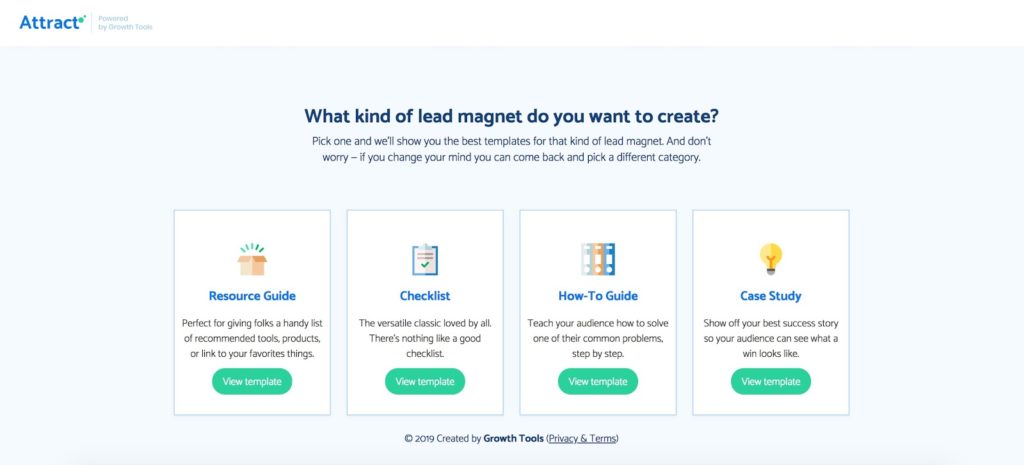
You can get your free account here and create a lead magnet for your content upgrade in minutes.
Step #2: Put multiple calls to action about your content upgrade in your blog post.
One of the biggest mistakes you can make in content marketing is to wait until the end of your blog post before you tell readers about your content upgrade.
I recommend including a call to action to download the content upgrade in the intro to your blog post as well as at the end.
For example, in this post we published about product launches, we included a headline, quick paragraph, and callout box to ensure readers know about the content upgrade. That way, they’re much more likely to opt-in for it whether they read the entire post or not:
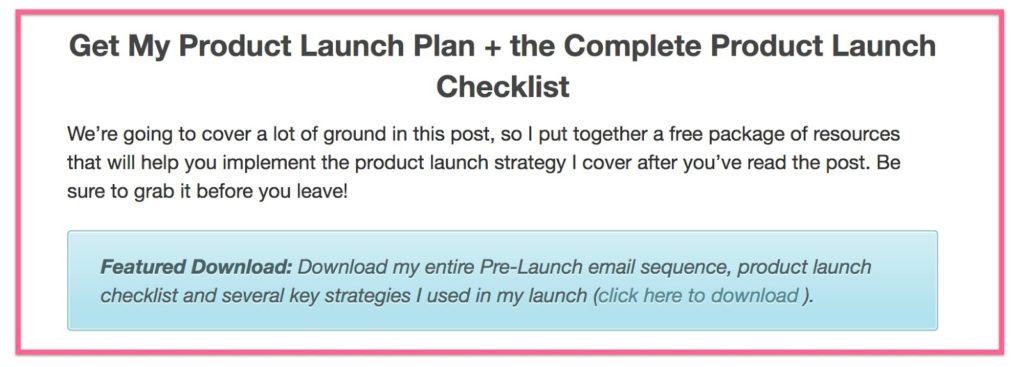
Explain the value of your content upgrade and how it will help them accomplish something related to the content of your post.
You already put the time into creating great content people like, so why not start maximizing that content’s ability to grow your list? That’s exactly what content upgrades will do for you.
You should implement this strategy if:
- You’re getting consistent traffic every month to at least one blog post.
- That blog post (or posts) isn’t currently converting at least 10% of visitors into email subscribers.
Like I mentioned earlier, it’s not uncommon to start converting 20% of readers into email subscribers with content upgrades, or at the very least doubling a post’s current email sign-up conversion rate.
9. Double the Effectiveness of Partner Webinars with One-Click Opt-Ins
I’ve already written extensively about how to use partner webinars to rapidly grow your email list.
Long story short: they’re one of the most effective strategies you can use if you want to grow your list in BIG chunks. I know because I once spent 6 months focusing on no other list-building strategies but partner webinars.
At the beginning, I had 10,000 subscribers on my list. Six months and 22 partner workshops later, I had 25,000 subscribers. That means I averaged 1,136 subscribers per workshop.
On the surface, they’re pretty simple:
- You find a potential partner with an audience that is interested in your topic.
- You pitch that partner on co-hosting a webinar where you will teach their audience something valuable about that topic.
- The partner sends emails to their subscribers to tell them about the webinar.
- Their subscribers open the email.
- If they’re interested, they click a link to go to the webinar sign-up page.
- They read more about the webinar on the sign-up page.
- Some are still interested, but some drop off.
- The ones who are still interested enter their email address to register for the webinar.
The ones who register are now officially on your email list. And if you pitch a product during the webinar and they purchase it, you split the revenue with your partner.
The cool part is that you get new subscribers whether they buy or not.
However, there’s one specific strategy you can implement when running partner webinars that single-handedly doubles their effectiveness at growing your email list: one-click opt-ins.
And I wish I had discovered them way sooner.
See, when we went through the process I outlined above, we saw 60% conversion rates on our webinar registration pages, which is considered pretty good.
The downside, of course, was that 40% of the people who were interested enough to click through didn’t end up converting.
But once I stumbled on one-click opt-ins, we never lost those 40% of people again.
In fact, 100% of the people who clicked the link in a partner’s email ended up registering for the webinar and becoming a new subscriber.
This is how one-click opt-ins work:
- Partner sends an email.
- Reader clicks link in email.
- They are registered and opted in immediately.
In 2017, we added 21,000 new subscribers to our list with partner webinars.
8,400 of those subscribers would not have signed up if we had used webinar registration pages instead of one-click opt-ins.
Those 8,400 subscribers have accounted for $107,712 in sales.
Why does this work so well?
Because it removes the landing page.
If your partner is sending an email to someone to convince them to register for a webinar, why do they need to click through to a landing page and opt-in again? All that does is create more friction.
This is one of the few strategies I’ve come across that requires little work and produces immediate, substantial results.
So why doesn’t everyone do it?
Because for a long time, getting it to work from a tech standpoint was super complicated.
That’s why we created a simple tool that allowed us to set up these links with just a few clicks. And recently, we made it available publicly for anyone to use for free.
It’s called One Click, and you can get your free account right here.
To recap:
- Book a partner webinar using the step-by-step instructions I gave in this blog post.
- Create a one-click opt-in link using One Click.
- Increase the number of new subscribers you get from the partner webinar by at least 40%.
You should implement this strategy if:
- You have a topic/presentation that you can easily turn into a webinar.
- You’re already doing webinars.
You can expect to add 200-1,000 email subscribers to your list per webinar, depending on the partner.
10. Spike Your Organic Blog Traffic with This Basic SEO Checklist (for Non-SEO People)
For the first 2 years of working on Videofruit, I totally ignored SEO.
It didn’t matter how many case studies I read about other sites getting 1000s of free visitors a month from Google, it just seemed too confusing, too intimidating, too complicated.
Thankfully, my buddy Brian Dean (an actual SEO expert) finally slapped some sense into me.
He pointed out that you don’t have to turn yourself into an SEO guru to dramatically increase the amount of traffic you get from search engines. If you’re already blogging, you can spike your organic traffic by implementing a handful of basic SEO tweaks to your most popular posts.
Here’s what happened when I implemented his advice:
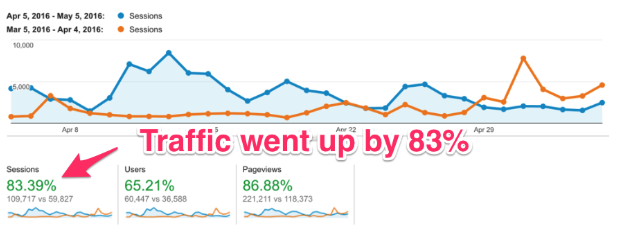
It took me about 2 hours to implement 5 basic SEO tweaks that resulted in over 40,000 new visitors and 3,500 email subscribers to the blog within the first month.
Note: Before you implement these tweaks, you’ll need to do 2 things:
- Identify your blog posts that have been linked to the most. (These are called backlinks, and they make it much easier to get search engines to rank your posts higher).
- Identify the best search keywords those posts have the potential to rank for.
For example, the original blog post I wrote about the Poster Boy formula had a lot of backlinks, but it wasn’t written in a way that would make it rank for the kinds of stuff people type into Google.
Even though the post helped tons of people get more traffic, nobody types the “Poster Boy formula” into Google when they’re searching for traffic strategies. They type things like “how to get more traffic.”
To figure out which search keywords would fit well with your own popular blog posts, use the step-by-step walkthrough I included in my post about website optimization.
Once you’ve done identified your most linked-to posts and the search keywords you want them to rank for, implement these 5 tweaks on each post:
Tweak #1: Put the keyword in the post’s title.
For example, if I wanted my Poster Boy blog post to rank for the “how to get more traffic” keyword, I could change the title from “The ‘Poster Boy’ Formula: How I Got My First 10,000 Readers” to “How to Get More Traffic to Your Blog with the Poster Boy Formula.”
Tweak #2: Tweak the post’s URL so it contains the keyword.
In this case, I would simply change the URL slug from /poster-boy-formula to /how-to-get-traffic-to-your-blog.
Note: Make sure to set up a redirect from the post’s old URL to the new one when you do this.
Tweak #3: Rewrite your intro with the keyword in mind.
Think about the mindset someone would have if they came to your post after Googling the keyword you have in mind.
Is the intro written in a way that would tell that person they’re in the right place?
Does it mention the keyword they searched for?
Tweak it so it does, and be sure to include the keyword in the first paragraph.
Tweak #4: Use the keyword several times throughout the post’s content.
Look for other opportunities to use the keyword throughout the post. Insert it where you can, but don’t force it.
Tweak #5: Give the post a good meta description.
The meta description is that chunk of text that people will see when your post comes up in Google:

If you use WordPress, it’s super easy to update this text with a free plugin like Yoast SEO. Make sure the new description mentions the keyword.
Is SEO complicated? It can be, sure. But if you have a blog and you ignore these super basic SEO strategies, you’re leaving tons of free traffic (and email subscribers) on the table.
You should implement this strategy if:
- You have a blog.
- You have 1 or more blog posts that other sites are linking to.
- You haven’t already optimized those posts for search keywords.
Your results will depend on the number of monthly searches that the keyword you select is getting. In general, I recommend aiming for keywords that are getting at least several hundred searches per month.
11. Get Interviewed on Top Podcasts in Your Niche
Nowadays, the joke is that everyone and their mom has a podcast.
And you know what? There’s some truth to that.
But the flip side to that joke is this: except for the top 1% like Tim Ferriss, Joe Rogan, etc. all those podcasts are starving for quality guests to interview.
So if you have something valuable you can teach a podcaster’s audience, you’re already way closer than you might think to get featured on it.
Here’s how to do it:
Step #1: Make a list of relevant podcasts your audience listens to.
Obvious, I know, but you want to make sure you appear on podcasts that the type of audience you’re trying to attract listens to.
If you need some ideas, make a quick list of topics related to your primary topic that your audience would be interested in. For example, if your website is about fly fishing, your list might include things like camping, deep-sea fishing, father/son activities, etc.
Then, take each of those topics and google “topic name” + “podcasts.”
Boom, you’ve got your list.
Step #2: Pitch the best targets.
A quality podcast interview pitch contains 3 elements:
- It gives your target an anchor.
Think of an anchor as a common point of interest between you and the person you’re pitching. It gives them a signal that you’re someone they can trust and not just some random weirdo on the internet.That means you might:
- Mention a specific episode you liked and how it helped you
- Mention a positive outcome you’ve experienced as a result of a particular episode
- Mention a specific episode you shared with others
Important: Don’t BS this part. Do your homework and actually listen to the podcast before you pitch the host. If you’re not sincere, it will show.
- It explains the win for them.
I can’t stress this enough—tell them specifically why you think their audience would enjoy the interview.And if you have an existing email list or social platform where you can promote the episode you would be on, let them know about it.
-
It has a clear ask.
Make it easy for the podcaster to give you a clear yes or no answer. Don’t beat around the bush.
Here’s an example pitch done in this style. It’s pitching giving a presentation for a Facebook group, but it would work exactly the same for a podcast:
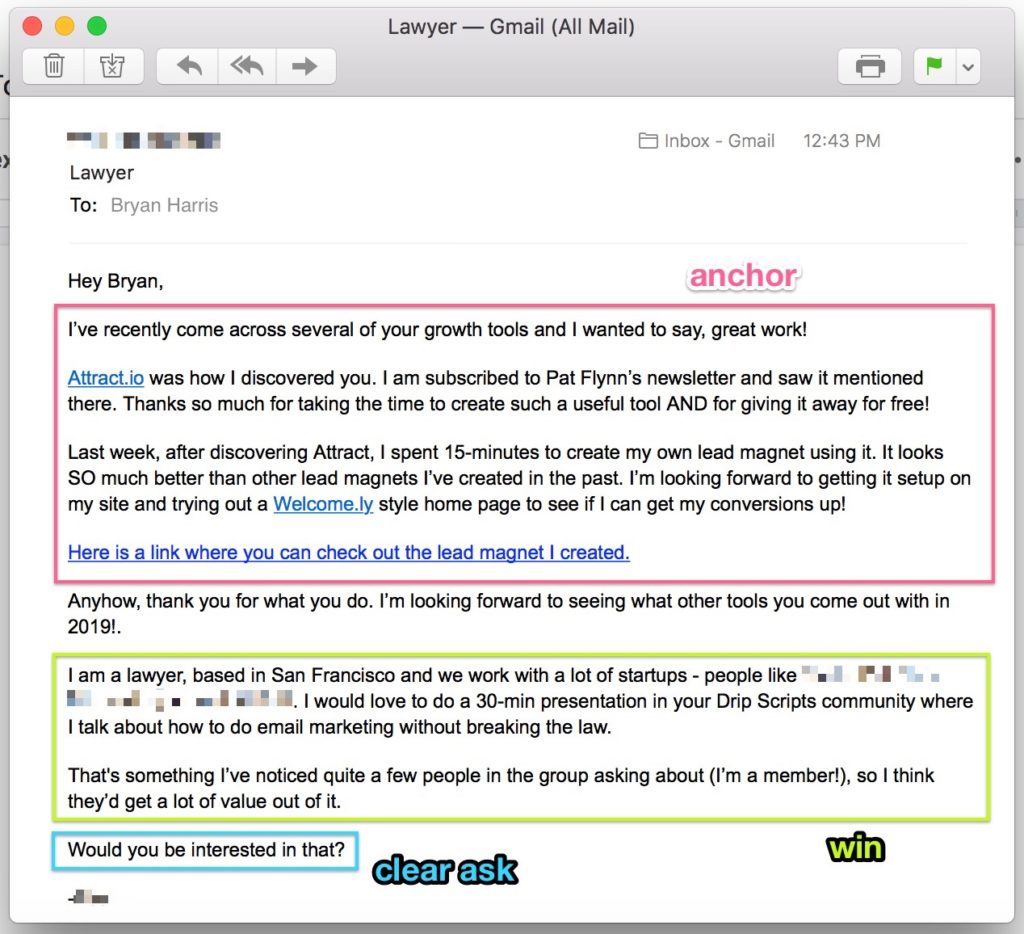
Step #3: During the interview, give away a content upgrade.
Create a simple bonus resource that’s specifically related to the content of your interview on the podcast and give listeners an easy-to-remember URL where they can opt in to receive it.
Approach this step exactly how you would if you were offering a content upgrade on a guest blog post.
This strategy works best for people who:
- Enjoy talking/teaching in a live setting.
- Can offer promotion of the podcast episode in return. (This isn’t required, but it’s always a plus if you have even a small list of subscribers you’ll be able to promote the episode to.)
The great part about being interviewed on a podcast is that most interviews become evergreen, meaning people continue to listen to them for years to come as new listeners discover the podcast and work their way through the archives.
Even a smaller podcast that gets only 1,000 or so downloads per month can easily produce 100+ subscribers for you over time. And the more podcasts you do, the faster that number adds up.
12. Bring in a Windfall of Subscribers with a Giveaway
A couple of years ago, I came across an episode of Pat Flynn’s podcast about a guy who added 60,000 subscribers to his email list by hosting a giveaway.
Once I picked my jaw up off the floor, I quickly cobbled together my own giveaway in about 3 hours.
The prize? A 10-year subscription to a tool I talked about frequently on my blog at the time called Leadpages.
All people had to do to enter was sign up for my email list. They could also get additional entries by sharing the giveaway and getting more people to sign up.
The results? A week later, 2,239 people had entered the giveaway and joined my email list:
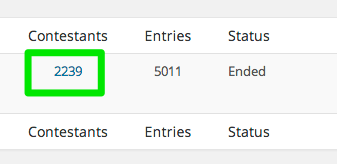
I didn’t come close to duplicating the results of the giveaway that brought in 60,000 subscribers. But getting 2,000+ subscribers in the span of a single week is a win I’ll always take.
There are 3 key steps to hosting and promoting your own giveaway.
Step #1: Pick the right prize and create your giveaway.
Repeat after me: no amount of promotion will overcome a crappy prize.
If you want awesome results, you need to give away an awesome prize. To be that, it needs to have 3 characteristics:
- Highly Desirable: It needs to be something your target audience would LOVE to get their hands on. My audience was people who wanted to build an email list, and Leadpages was one of the best tools for doing that at the time.
- Shocking: It needs to sound almost too good to be true (unlike the all-to-common iPad giveaways). I didn’t say “Win a $2,000 Leadpages Subscription.” I said, “Win a One-Decade Subscription to Leadpages.” When you settle on a great prize, make sure you give it a great hook.
- Authority Leaching: Pick a prize owned by a person or company who is likely to help you promote the giveaway. For example, my audience also probably would have loved a brand new MacBook. But obviously, a company as big as Apple isn’t going to promote some random dude’s giveaway. Leadpages, however, was much smaller but still highly influential with the audience I was trying to reach, which made it relatively easy to make this happen:
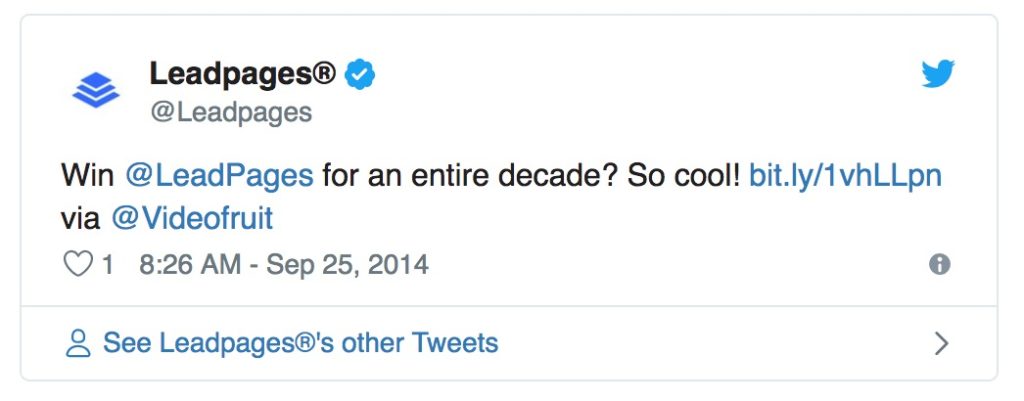
Step #2: Promote your giveaway.
There are tons of different things you can do to promote a giveaway like this, but there were 5 I found particularly effective.
Two of them were obvious: I reached out to everyone I had an existing relationship with and asked if they could help, and I also emailed my own list about the giveaway.
Here were the 3 not-so-obvious strategies:
- Manual outreach to podcast interviewees
Find anyone who has been interviewed about your topic or related topics in the last 90 days and ask them to share the giveaway.
Since Leadpages had a podcast, this was fairly straightforward for me. I sent a message to everyone they had interviewed and asked if they would mind sharing.
If the company that makes the product you’re giving away doesn’t have a podcast, just find a podcast that’s related to it and do the same thing. For example, if you’re giving away a Whole Foods gift card, you can reach out to guests who were on some of the top health/fitness podcasts.
Reaching out to podcast interviewees brought me 620 new subscribers.
- Manual outreach to bloggers
Just like every topic/industry has podcasts dedicated to it, they also have blogs dedicated to them.
When I did the Leadpages giveaway, their blog ran monthly roundup posts that featured unique landing pages their users had created. I reached out to dozens of people who had been featured in those posts and ended up getting an additional 590 entries/subscribers as a result.
To find relevant posts for your industry, just do a quick Google search for “best [keyword] blogs.” For example, if you’re giving away a Whole Foods gift card, you could search “best organic food blogs.”
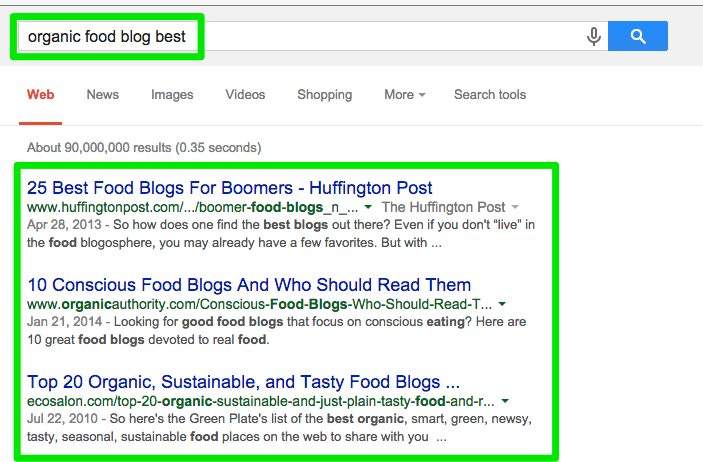
- Manual outreach to backlinkers
I also reached out to anyone who had linked to a Leadpages article in the past 90 days. It only took 2 steps to find them:
Step #1: I typed the Leadpages’ blog URL into a tool called BuzzSumo, which gave me a list of their most shared recent articles:
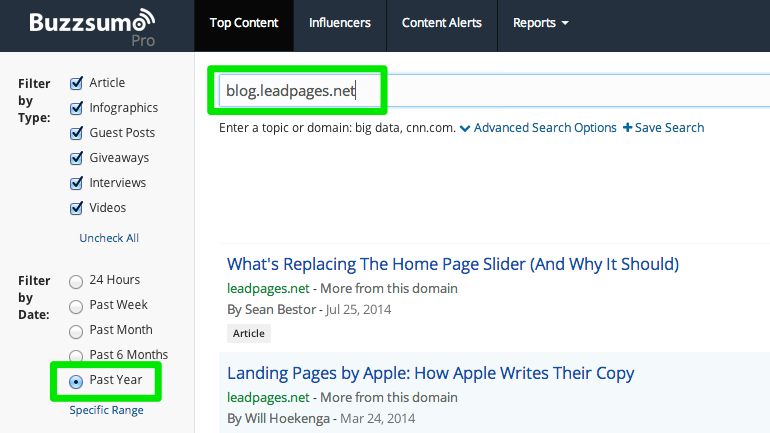
Step #2: I entered each article’s URL into Moz to get a list of websites that had linked to each article:
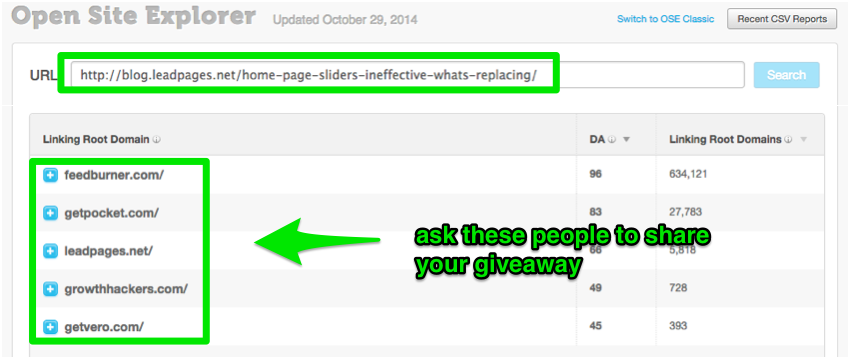
Then I emailed the owner or editor for each site and asked them to share the giveaway.
This strategy got an additional 325 people to enter the giveaway and join my list.
You should implement this strategy if:
- You have the budget to invest in a highly valuable giveaway prize.
- You’re willing to invest the time to effectively promote the giveaway.
If you select a prize that is truly desirable, and you follow all of the promotional strategies I outlined, you can expect to gain 1,000+ subscribers from your giveaway, although I’ve seen many people dramatically exceed that.
Additional Giveaway Training: If you want to see copies of every email I sent while promoting my giveaway, plus tutorials on how to run all the technical aspects of it, check out the original in-depth blog post I published about it.
13. Get Dirt Cheap Leads from Facebook with the “Reverse Facebook Ad” Framework
I’ve said many times that I don’t usually recommend running paid ads to build your email list until you’ve hit 10,000 subscribers.
As you’ve seen so far in this post, there are SO many great list-building strategies that require no investment of money that introducing the complexity and cost of Facebook ads can turn into a huge (and expensive) distraction.
BUT…
There is one Facebook advertising framework that’s so simple and easy to implement I don’t mind recommending it if you’ve got the budget to invest some money into growing your list. (It also helps if you have a product/service available so you can generate ROI.)
It’s called the Reverse Facebook Ad Framework. Here’s how it works:
Step #1: Identify your most popular piece of content that’s related to a paid product.
What have you already published that really resonated with potential customers?
Anytime you get a great response to a piece of content (whether it’s comments, shares, emails, traffic, etc.), that’s a clue that you’re onto something.
Instead of trying to come up with some new concept for an ad campaign from scratch, just use what’s already proven to work.
For example, when I first asked myself this question, I immediately thought of a popular post we’d published called “How to Make $1,000 in the Next 14 Days Without an Idea.”
Something about it just clicked with people. Plus, it also tied directly into the topic of a course we offered. People interested in the content from that post would likely also be interested in the product.
Step #2: Turn 1 component from that piece of content into a lead magnet.
This doesn’t need to be complicated.
Is there a certain part of the piece of content that people really liked or found useful? Could you turn it into a simple checklist or downloadable PDF?
For example, in the blog post I mentioned earlier, there was a list of business ideas that people really liked. So we turned it into a simple spreadsheet:
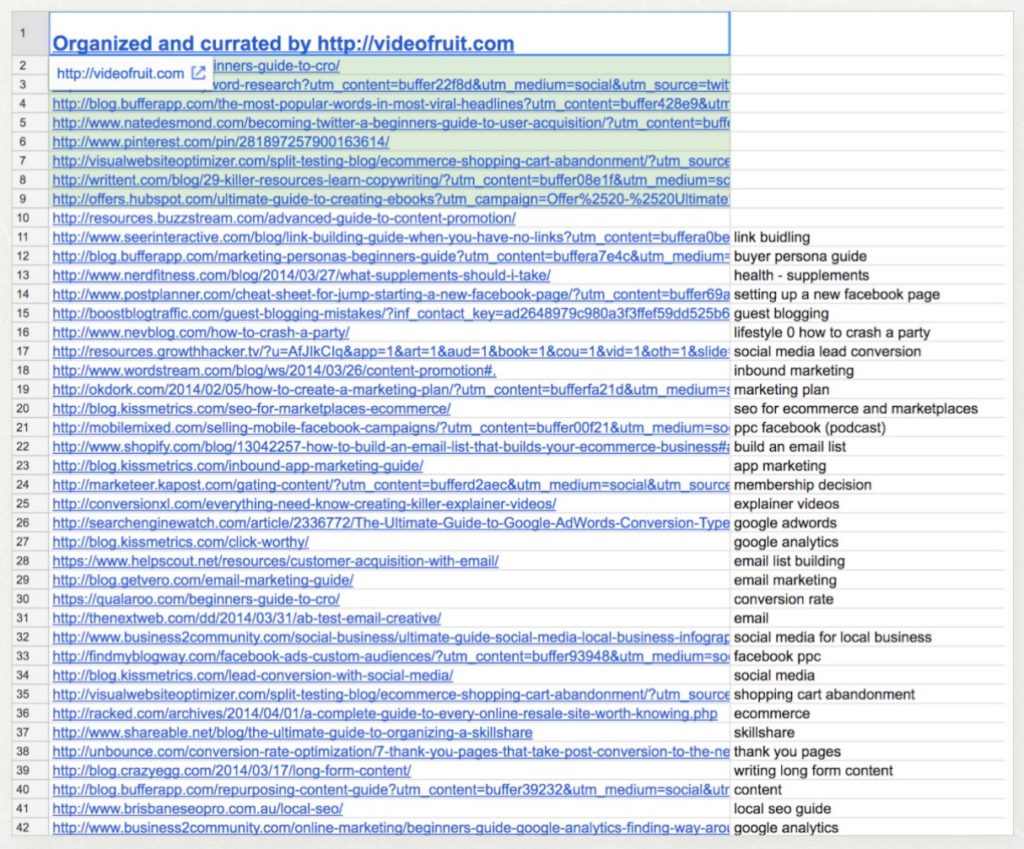
No fancy design. No new content from scratch. No big time suck to create.
Keep it simple.
Step #3: Create an ad that offers the lead magnet + a free webinar.
Since you’re basing the ad on something you’ve already created, you already have tons of proven copy from the original content you can easily adapt to fit your ad.
We simply took a screenshot of our lead magnet, highlighted the main benefit the user would get, and listed a few bullet points about how it works:
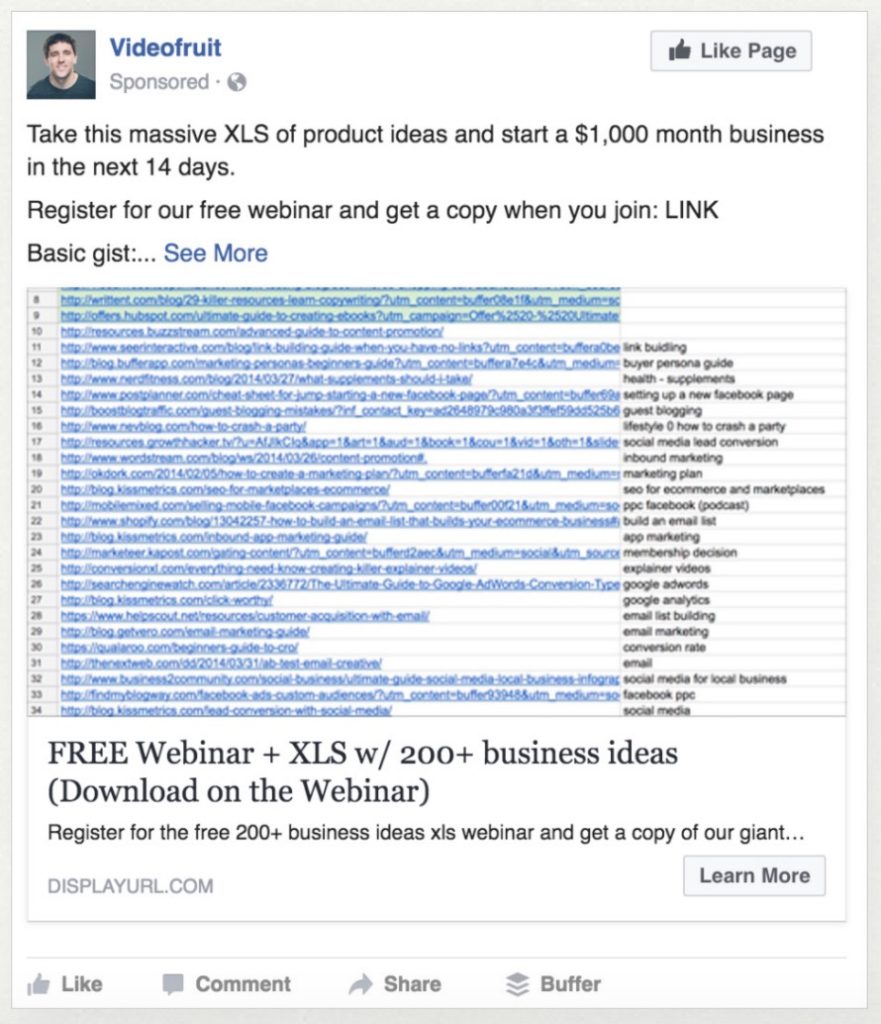
Why offer a webinar on top of the lead magnet? Because that gives you an incredibly simple way to get quick ROI. All you need to do during the webinar is:
- Give away the lead magnet you promised.
- Teach the information from the original piece of content you based the lead magnet on.
- Pitch your paid product/service that’s related to the content.
When we first tried this strategy, we started with a $500-per-week ad spend. On our first webinar, we made $350 back while collecting 300 new email subscribers. So we lost money, but also grew our list by 300 subs in the process.
But by the time we’d spent $1,500, it was paying off in a big way. We’d gotten 750 people to sign up for the webinar and join our list, and sold $4,000 worth of product.
So basically we got paid $2,500 to grow our list by 750 people.
You should implement this strategy if:
- You have the budget to invest in paid ads.
- You have proven content that would easily translate into this kind of ad campaign.
- You’re comfortable putting together a basic sales webinar.
Your results will obviously depend on the quality of your webinar and ad campaign, but as you can see from our experience, this strategy can make a big impact on your list and revenue quickly.
14. Be the Bonus for Someone Else’s Launch or Promotion
This strategy allows you to get your business in front of hundreds of proven buyers by taking advantage of what every business needs during their launches and promotions: bonuses!
Take a quick look at any launches you’ve been emailed about in the past year and you’re likely to find emails that offer bonus items to customers who purchase within a specific timeframe.
But here’s the secret about many of these launches…
The businesses running them are ALWAYS looking for more cool bonuses they can package with their offer to make it more appealing.
For example, here’s an email John Meese sent me asking if I’d be willing to include one of our products as a bonus for his launch:
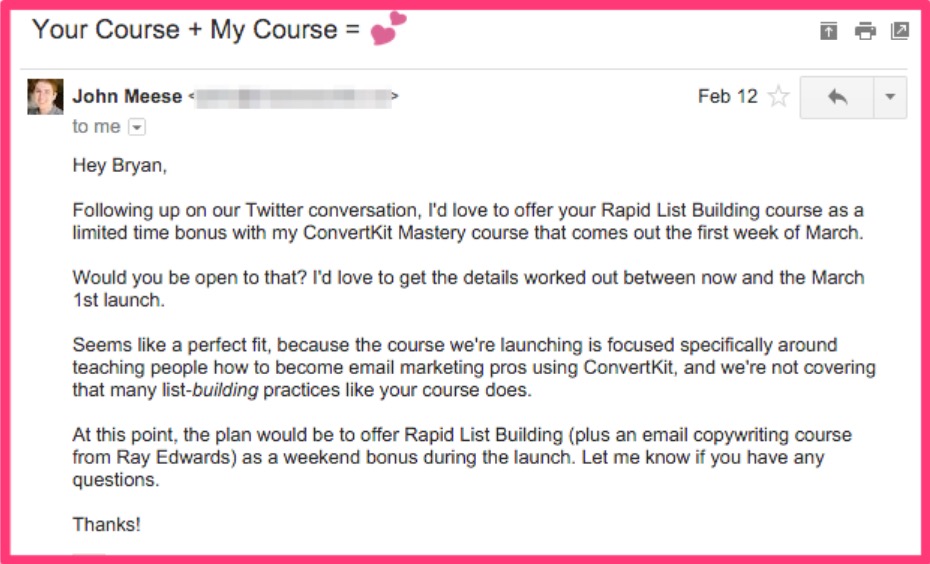
This is where you come in.
Instead of waiting for someone to ask you to contribute a bonus, you proactively reach out and offer one of your mid-priced products ($50 to $200) to someone with a similar audience who is doing a product launch.
For example, if you have a course on yoga and you know someone who is launching a product on nutrition, you could offer your course as a bonus.
They benefit by having more value baked into their offer, and you benefit by getting their list of customers so you can fulfill your product and add them to your email list.
The process behind this strategy is simple:
- Step #1: Identify a contemporary launching a product similar to yours.
- Step #2: Reach out and offer your product to them as a bonus for their product.
- Step #3: You each keep the leads for each sale.
You should implement this strategy if:
- You have a mid-priced ($50 to $200) product to offer as a bonus.
- You have a higher-priced product or service you can sell to the leads you get in the future.
Your results will depend on the number of sales generated by the launch you’re participating in. Remember, though, every lead you get from this strategy is a proven buyer. They can often convert into some of your most valuable customers once they get to know you and your brand/business.
15. Organize a Virtual Summit and Attract 10,000+ Subscribers
Alright, I’m gonna keep this simple.
The virtual summit is a monster strategy. It takes monster focus and monster execution.
But it also produces monster results.
Just ask Chandler Bolt.
He created a virtual summit around the topic of self-publishing that generated 25,000 email subscribers and $350,000 in sales in a 10-day period.
The concept is simple. A virtual summit is a big free online event where you interview a dozen or so experts on a particular topic and they all promote it to their audience. Like this:
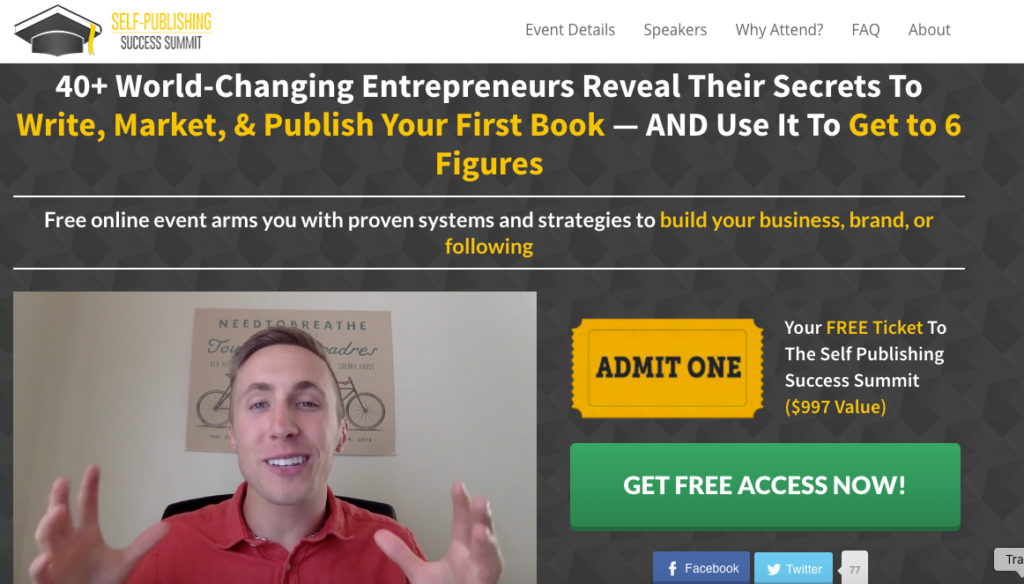
Think of it as a series of pre-recorded webinars that each teaches your audience something valuable.
Here’s the basic overview of how virtual summits work:
- You pick a topic for the summit (something related to your business).
- You invite a handful of people to speak at the summit.
- You interview each speaker ahead of time.
- You ask each speaker to promote the event.
- 20-40% of the speakers agree to promote it.
- You release the interviews with each speaker over a 10-day period.
- Each speaker sends new subscribers and customers to your list when they promote it.
- You promote products to everyone who registers for the summit and split the revenue 50/50 with the speakers.
As I said, it’s a monster strategy. If I broke each step down in detail, it would double the length of this post.
Fortunately, we already published a full step-by-step virtual summit breakdown right here, including email scripts for reaching out to speakers, landing pages, promotion calendars, and more.
You should implement this strategy if:
- You’re willing to spend ~3 months focusing on organizing and promoting a virtual summit.
- You enjoy interviewing people.
- You’re great at planning and coordinating lots of moving parts.
I’ve seen both early-stage companies and solopreneurs like Chandler and big, thriving businesses add 10,000+ subscribers to their email lists with virtual summits. If you’re up for the challenge, the reward can be massive.
Part 3: Accountability — 3 Ways to Guarantee Your Email List Growth
Now, I’ve walked you through our Top 15 Recommended List-Building Strategies and showed you exactly how to discover which ones are most likely to work best for you.
But, like I’ve said many times before, strategies alone are not enough.
Strategies alone won’t stop you from getting distracted and losing focus on your list.
Strategies alone won’t motivate you to keep showing up and to stay focused week after week.
Strategies alone won’t keep you accountable.
But the 3 systems I’m going to show you today will.
I know words like “accountability” can give off Afterschool Special vibes, but I honestly believe it’s the most underrated factor in any successful list-building story.
Over the years, nearly every person I’ve seen build a large list did something—whether consciously or unconsciously—to hold themselves accountable and force themselves to keep taking action.
There are 100s of different ways to do it, but the 3 approaches you’ll find below hit the sweet spot of effective and easy to implement.
So take the next 5 minutes to check them out, pick one, and take the first step toward implementing it.
Accountability System #1: The “Scary Consequences” Contract
I first tried this strategy after my father-in-law passed away several years ago.
There were a variety of factors that contributed to his passing, but most of them stemmed from him being overweight. It was a huge wake-up call for me.
I’d been concerned about my own weight for a while but couldn’t seem to find a diet/exercise regimen I would actually stick to, so I took drastic action.
I signed a 1-page contract with myself that spelled out my goal for the quarter and 2 health-related action items I had to complete every day that I knew would help me accomplish it.
Two other people also signed the contract, and if I failed to complete my action items for even ONE day, I owed them $200. I gave them the signed check right off the bat so they could cash it if I failed.
The result?
They never once got to cash those checks and 2.5 years later I’m still regularly exercising and eating a WAY better diet, and overall I’m much healthier.
Here’s an example of a similar “Scary Consequences” contract I created after that one:
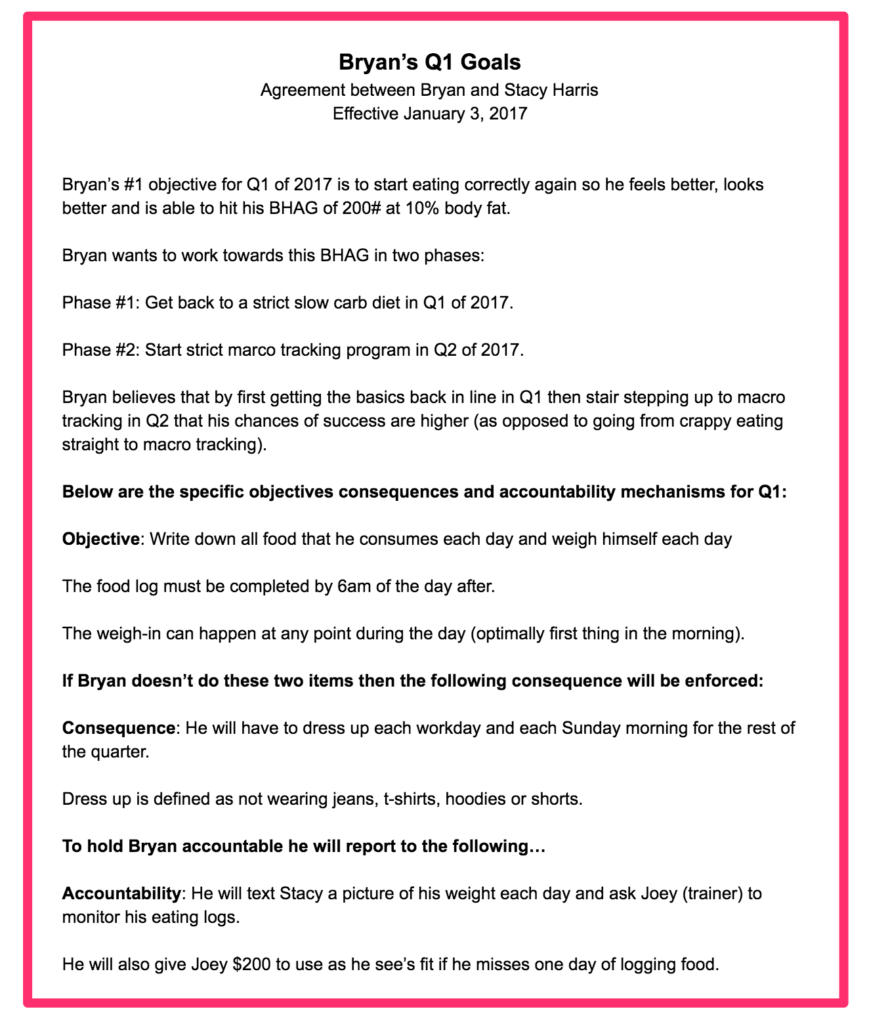
Notice a few key things about it:
- The scary consequences are not tied to whether I achieve my goals or not. Instead, they’re tied to whether I take daily action on a handful of small tasks that will make me more likely to hit my goals. This is important. The goal of accountability is to make sure you stay focused and keep taking action, not to punish yourself if you fall short.
- The contract only lasts for a ~90-day period. I’ve found this is enough time for you to get a sense of whether the action steps you’re committing to are effective or not. After 90 days, you can assess your progress and decide if you need to stay the course or change things up with a new contract.
- It spells out WHY I’m setting these goals. The simple act of writing why you’re choosing your goal(s) is a great way to make sure they’re actually good goals. Have a hypothesis for why they’re likely to help you.
- Your scary consequence doesn’t have to involve money. Not everyone’s cool with putting cash on the line. I get that. But losing money is definitely not the only consequence you might find scary. Trust me, I was WAY more frightened by the idea of having to wear nice clothes every day than I was of losing $200. Just make sure that whatever consequence you choose is something that the other person signing the contract would kind of like to see happen. That’ll motivate them to stay on your case. 🙂
You can create the exact same type of contract to keep yourself accountable with your list-building efforts. For example, your action steps might be things like:
- Write 250 words every day (if creating content is a big part of your list-building plan)
- Send at least 5 outreach emails per week (if you’re implementing strategies that require outreach)
- Write down your daily list growth at 5 PM every day (easy if you use List Goal)
Again, these action steps don’t have to be complicated or crazy difficult. They just need to force you to make regular progress and stay focused on growing your list.
Accountability System #2: Turn List-Building into a Friendly Competition with the Spar App
Are you competitive? Then you need to meet the Spar app.
Here’s the basic gist:
- You create a challenge or goal. For example, “Sending 2 Guest Email pitches per week.”
- You invite people who have the same (or similar-ish) goal to participate.
- You snap a quick video “check-in” when you complete the challenge/goal.
- If you miss the check-in, you have to pay a penalty fee. Something small like $5 or $10 usually works well.
- The winner gets to keep all the penalty money.
Spar actually makes accountability feel pretty fun and it’s surprisingly effective. Even if the challenge is tiny:
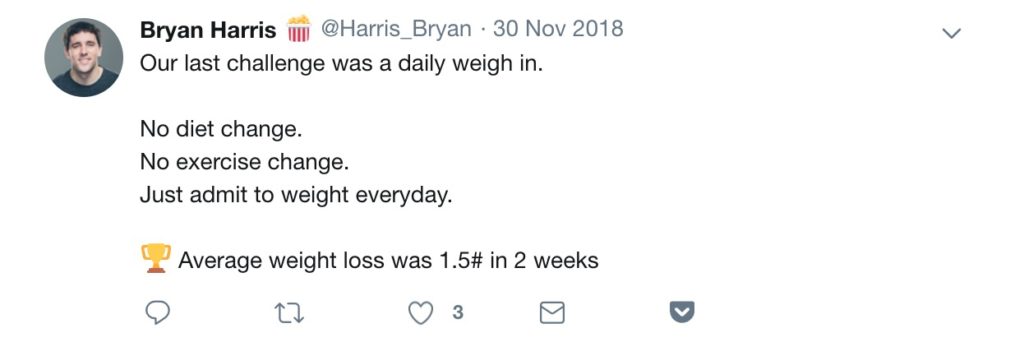
Another cool thing about Spar is it’s pretty easy to find people to join your challenge (even if you think you don’t know anyone). Here are 3 places you can try:
- The comments section on this blog post! Explain your challenge and post a link to it below. Something tells me other people reading this post just might make the perfect sparring partners for you. 🙂
- Facebook groups related to email list-building. Post a link to your Spar challenge and see if anyone wants to join. For example, you could try posting in the Facebook community we built for our free email sequence tool, Drip Scripts.
- Twitter/Instagram. Challenge your followers to compete with you. I’ve Sparred with tons of cool people I didn’t know before by doing this.
Accountability System #3: I’ll Check in on You Once a Week for the Next 90 Days
I used to recommend finding a friend to check in with on your progress once a week via email or text.
For some people, it works great.
For most, unfortunately, it doesn’t. I’ve typically found that if there isn’t some sort of reward/penalty baked into the system, the check-ins start to fizzle out after a couple of weeks. Or they end up just being messages like, “Oh man I totally forgot this week.”
And that’s if you even go to the trouble to rope one of your friends into doing it in the first place.
BUT… that doesn’t change the fact that simple email reminders can be a powerful way to keep you on your toes.
So forget unreliable friends. I’ll be your friend instead. 🙂 Here’s how it works:
- Click here and pop in your email address.
- I’ll send you a weekly email with a checklist of simple action items that will keep you on track with whatever email list-building strategies you’re implementing.
- After 90 days, you’ll assess your progress and recalibrate your approach accordingly.
Even if you’re already planning to implement either of the first 2 strategies, I highly encourage you to do this one too. It costs you nothing and it’s one more way to failure-proof your progress.
Click here and I’ll start checking in with you once per week (for the next 90 days).
I know it might seem small, but taking a few minutes to set up at least 1 of these 3 accountability systems can make a massive difference on the list-building progress you’ll make over the next few months.
Don’t underestimate it!
Part 4: Adjustments — Stay on Track with the 90-Day Review
The original promise of this blog post was that it would help you grow your list more in the next 8 weeks than it grew in the last 8 months.
That’s exactly what Parts 1 through 3 will do.
Part 4 shows you how to continue replicating that growth, again and again, no matter what changes, using 1 simple process:
The 90-Day Review.
The 90-Day Review is what ensures you’ll CONTINUE finding and focusing on the right strategies as your list grows.
Because the reality is, your skills will change. Your resources will change. Sometimes even the types of people you’re trying to attract will change.
But when you’re knee-deep in the weeds of trying to grow your business, it’s super easy for that stuff to go unnoticed.
For example:
For the first 3 years of Videofruit, I published one long, in-depth blog post every week. It’s what the site was known for.
But after 3 years of doing it week after week, I was completely burned out on creating content.
So the whole team came together one day with one question in mind: How else can we grow?
The answer ended up being so obvious I felt like I owed myself a punch in the face.
It turned out, when we actually analyzed exactly where our leads were coming from, blog content was nowhere near the top of the list.
Meanwhile, partner webinars and software tools—something I spent only a fraction of my time focusing on—were by far our biggest source of leads. If you compared them on a chart, it basically looked like this:
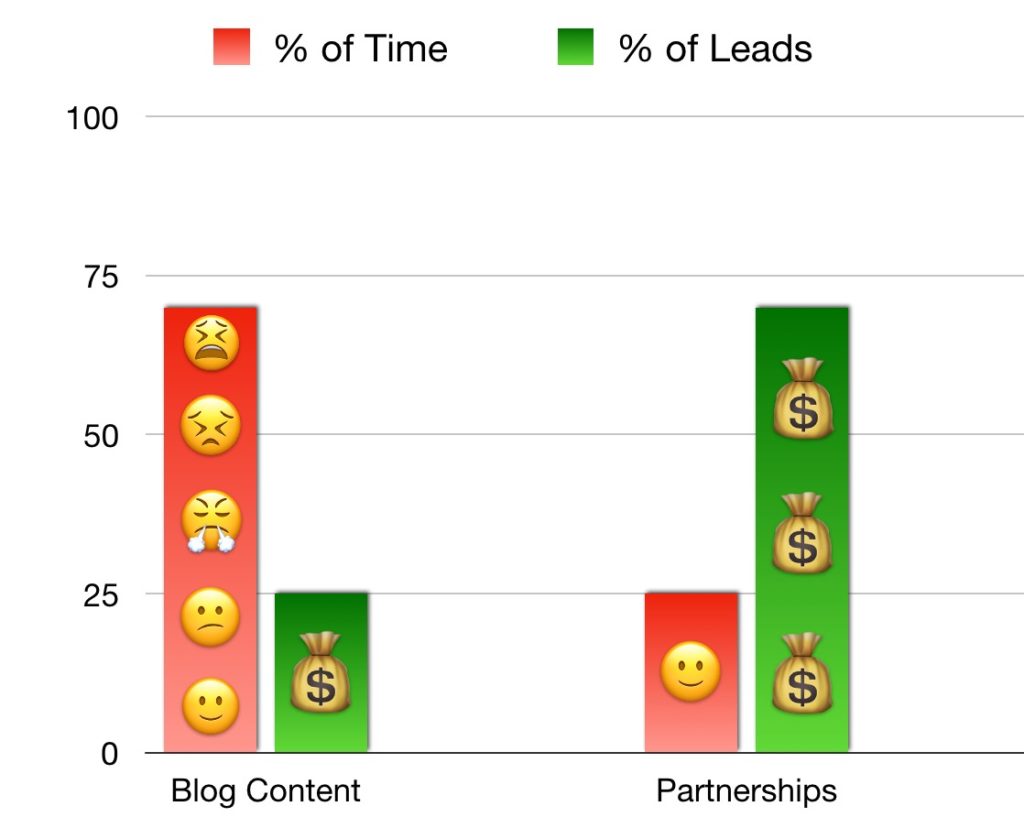
*mind = blown*
We immediately changed course. All that time I’d been putting into blog content went into generating bigger and better partnerships instead.
In fact, we went 1.5 years without publishing a new blog post.
The results? We 10x’d our list growth over the next year. And I probably 10x’d my sanity. 🙂
Since then, we’ve implemented a mandatory 90-Day Review process not only for our own company, but also for everyone who goes through one of our courses or coaching programs.
The 90-Day Review prevents you from burning out. It cures “shiny object syndrome.” It stops you from pouring MONTHS of your time into strategies that aren’t actually moving the needle.
And it’s as simple as asking yourself 5 specific questions 4 times per year.
But before I show you those questions, here is the #1 rule for the 90-Day Review:
Don’t make it exhausting.
The 90-Day Review doesn’t need to be some kind of vision quest where you lock yourself in a remote cabin for a week and ponder the meaning of life.
Think of it more like checking in on the Thanksgiving turkey after it’s been in the oven for 90 minutes. You’re looking at the major stuff and making adjustments as needed.
Is it still on track to be done in time for dinner?
Does it look like it’s drying out?
What’s the internal temp?
Is it time to start the green bean casserole yet?
Wait, is Uncle Steve already on his fourth glass of wine?
You’re going to ask the same types of questions about your progress growing your email list over the last 90 days.
No plan or list-building strategy continues to work without adjustments. Use the following 5 questions to pinpoint any issues or opportunities and adjust your strategy accordingly for the next 90 days.
Question #1: On a gut level, what worked well?
When I say “gut level,” I mean gut level.
Don’t kick off your 90-Day Review by pulling up Google Analytics and getting lost in a bunch of numbers. That’ll just give you a reason to procrastinate.
Instead, think about the last few months and ask yourself:
- What stood out?
- When did you get the most excited?
- What wins did you have?
- What did you really enjoy doing?
Even if you think of stuff that feels small, write it down.
Question #2: On a gut level, what did not work well?
Approach this the same way you approached Question #1. Think about:
- What felt like a waste of time?
- What did you not enjoy doing?
- What fears or anxieties did you experience the most?
- What felt like it did nothing to move the needle?
Make a separate list of everything that comes to mind right next to your list for Question #1.
Question #3: What were your biggest sources of new subscribers and traffic?
Now’s the time to get into the numbers a bit. But I still recommend keeping this as simple as possible.
Remember, we’re focusing specifically on your email list growth—not revenue, sales, or anything else.
These are two primary numbers you should try to get a feel for as best you can:
- Leads / Subscribers
What were your top 3 to 5 sources of new subscribers? These sources might be things like posts on your blog, guest posts, landing pages, etc.
If you instantly know some of these off the top of your head, feel free to write them down. For example, sometimes you don’t have to check Google Analytics to remember that a particular guest emailing campaign doubled the size of your list.
The bigger your list is, however, the more important it becomes to actually check the numbers on your site and opt-in forms. If you’re already averaging hundreds of new subscribers per month, it can be easy to lose track of where they’re all coming from.
- Traffic
With traffic, you want to get a sense of what generated the most traffic, and what received the most traffic.
For example, knowing that a particular blog post received more traffic than any other page on your site is helpful because you can then apply specific strategies to that page to make it convert more visitors into subscribers.
However, it’s also helpful to know WHY that particular post received so much traffic. What was responsible for generating it? Did someone influential share it? Is it getting lots of organic search traffic?
Asking this question should leave you with a list of:
- Your top 3 to 5 sources of email subscribers over the last 90 days
- Your top 3 to 5 highest traffic pages
- Your top 3 to 5 biggest traffic sources to those pages
Question #4: What’s changed?
A lot can happen in 90 days.
The more work you’re putting into growing your list, the likelier it is that you might have new or improved skills, resources, and/or relationships by the time you conduct your 90-Day Review.
Take 5 minutes to make a list of what’s changed in those 3 areas:
- Skills: Has your confidence in any particular skill grown? For example, maybe after doing several podcast interviews over the last 90 days, you feel confident enough in your speaking ability to give webinars a try. Or maybe after publishing 10 blog posts, you feel confident enough in your writing to start reaching out for guest blogging opportunities.
- Resources: Do you have more revenue to invest in your list growth now than you did 90 days ago? Has your traffic or total number of subscribers increased significantly? As those increase, so will the number of effective list-building strategies available to you, so it’s important to take note.
- Relationships: Have you established any new connections with potential partners, influencers, or companies with audiences who would be interested in your business? Don’t worry about how you might utilize those relationships, just write them down.
Question #5: What will you implement over the next 90 days?
After you’ve answered Questions 1 through 4, you’ll likely already have a few ideas about what you should or shouldn’t implement over the next 90 days.
I recommend making a list of 3 things:
- Strategies you want to continue or double down on
If your answers to Questions #1 and #3 uncovered stuff that worked well, list the specific strategy tied to it here. For example, you might write “run more giveaways” or “book 3 more partner webinars.”
- Strategies you want to cut (or spend less time on)
Question #2 will probably produce a few obvious things to list here. But be sure to pay attention to your traffic/subscriber numbers. A lot of times, things you THINK are important to keep doing aren’t actually producing earth-shattering results. Don’t be afraid to scale something back a bit if it’s not performing.
- New strategies you want to implement
At the end of your 90-Day Review, take a few minutes to skim back through the Top 15 Recommended List-Building Strategies I detailed earlier in this post. Based on your progress, are there any new ones you’d like to try?
Make a list and run them through the ICE Framework from Part 1.
Your Action Items:
It’s easy to understand the value of the 90-Day Review.
It’s easy to get excited about implementing it 90 days from now so you can make the right strategic adjustments.
It’s even easier to completely forget about it and let that 90-day mark whoosh by without even realizing it.
So right now I want you to take ONE action:
Pull up whatever calendar app you use and schedule an event called 90-DAY REVIEW for 3 months from today.
(Don’t worry about it being exactly 90 days from now. 3 months is fine.)
In the description for that event, put a link to this blog post with this note: “You promised yourself you would do this when you read this blog post. Don’t back out now.”
90 days from now, you’ll have yourself to thank.
Go!
Part 5: Fast-Forwards — How to Unlock the “Shortcuts” That Will Dramatically Accelerate Your List Growth
Other than having the right list-building plan (which parts 1 through 4 of this post give you), the biggest factor for how fast you can grow your email list is 1:1 guidance and feedback.
In other words, the ability to get direct help from someone who has already accomplished what you’re trying to do when you need it.
For the longest time, I called this coaching.
Unfortunately, when people hear the word “coaching,” this is how they tend to think of it in relation to their business:
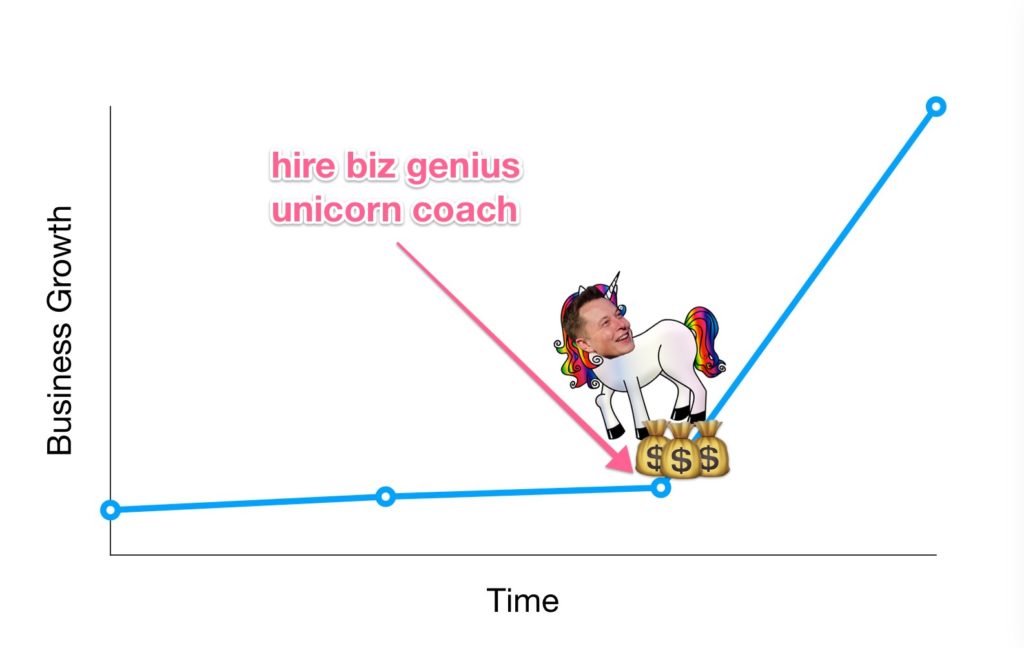
You spend years slowly growing your business in isolation and then hire a mystical guru who takes your business into the stratosphere.
In my experience, real coaching looks nothing like this.
When I look back on the most valuable guidance I’ve gotten over the years, it didn’t come from a single all-knowing source who descended from entrepreneur heaven and bestowed his teachings upon me.
Instead, it was a series of people who each helped me accelerate my progress on specific challenges or goals:
- When I wanted to get better at selling products online, I found someone who had specific experience selling products online.
- When I wanted to learn how to build a company, I found someone who had specific experience building healthy companies.
- When I wanted to improve at over-the-phone sales, I found someone who had specific experience selling over the phone.
Sometimes their guidance came free of charge in a single email.
Sometimes it came in the form of an hour-long conversation.
And yes, sometimes it was the result of a more traditional “coaching” relationship that unfolded over the course of several months.
That’s why think it’s more helpful to think of coaching in terms of “fast-forwards.” In reality, it looks a lot more like this:
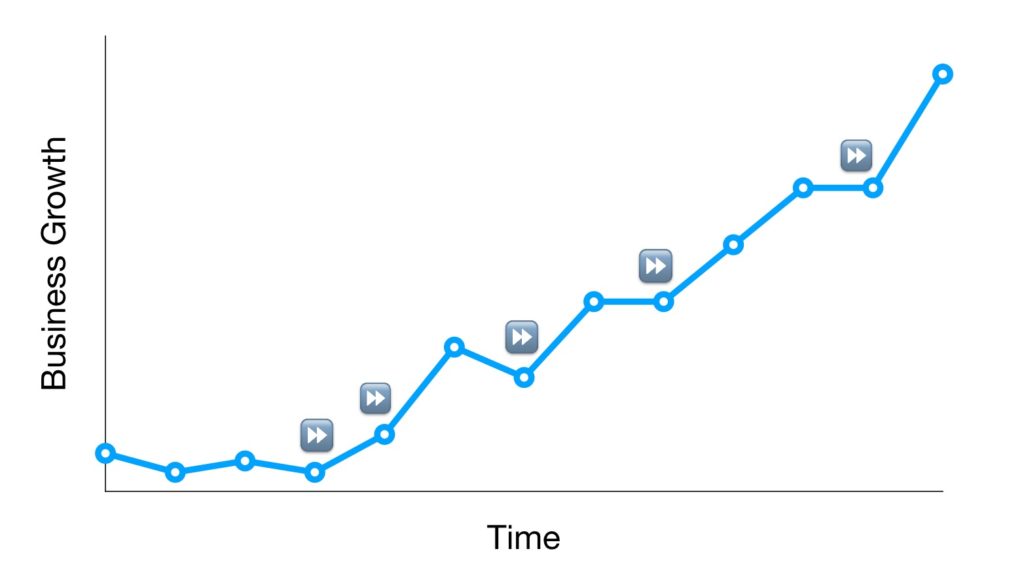
Fast-forwards come in all shapes and sizes.
You don’t need thousands of dollars or months of hour-long conversations to unlock them.
Forms of them are available to you no matter where you are in your list-building journey.
All you have to do is know where to find them.
Below, you’ll find my 3 go-to fast-forward sources and how you can leverage them to leapfrog past the biggest challenges you encounter when building your email list—whether you have a big budget, small budget, or no budget at all.
Fast-Forward Source #1: Get FREE advice from bloggers you admire.
Think about the biggest challenge you currently have with growing your email list.
Now, what if you could get detailed feedback from an influential blogger you admire on exactly what steps you should take to overcome that challenge?
And what if you could get it for free?
In many cases, you can.
All you have to do is know how to ask.
For example, let’s say you want to grow an email list so you can have a successful book launch and you follow Tim Grahl from BookLaunch.com.
How could you get Tim to give you some direct feedback on YOUR book launch?
You could use a little something I call the “Action-Report-Ask” Formula.
Quick Sidenote: Do NOT use this as an excuse to spam Tim. Or I will come after you with the fury of 1,000 burning suns. 🙂
The “Action-Report-Ask” Formula is based on the fact that 99% of the emails influential bloggers receive from their readers are, well… bad.
- They’re long-winded.
- They don’t have a specific ask.
- They offer little to nothing of value to the person on the receiving end.
“Action-Report-Ask” enables you to write an email that will stand out from the sea of mediocre ones flooding Tim’s inbox so you can develop a relationship and get his guidance.
Here’s how it works:
First, you would find the latest email you received from Tim and look for a specific action it asks you to take.
For example, here’s one he sent about a new blog post he published. Obviously, his goal is to get you to read the post:

Your goal is to take action on whatever Tim teaches and report back with results. How would you do that with this email?
I would take 5 steps:
- Read the blog post Tim links to.
- Identify something actionable Tim teaches in the post.
For example, in this post he tells readers to invite people they already know to join their email list (hey, that sounds like the Ambassador strategy!):
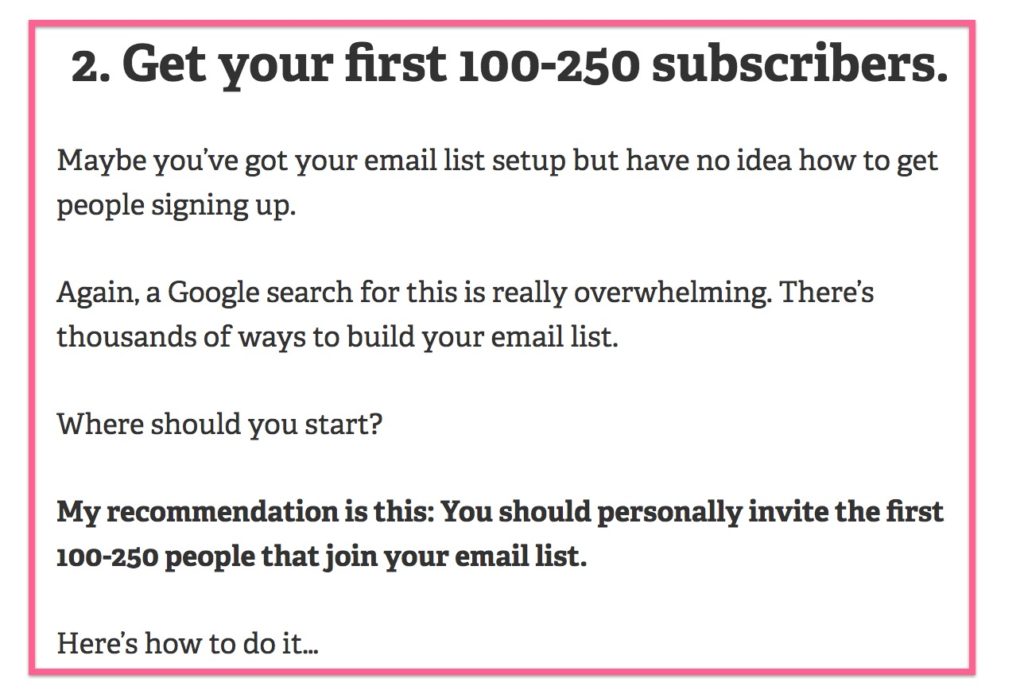
- Invite 100 people to join your email list based on Tim’s instruction.
- Wait a few days to see the results that come in.
- Reply to the original email you received from Tim with all the details of your experiment.
This is what I would write:
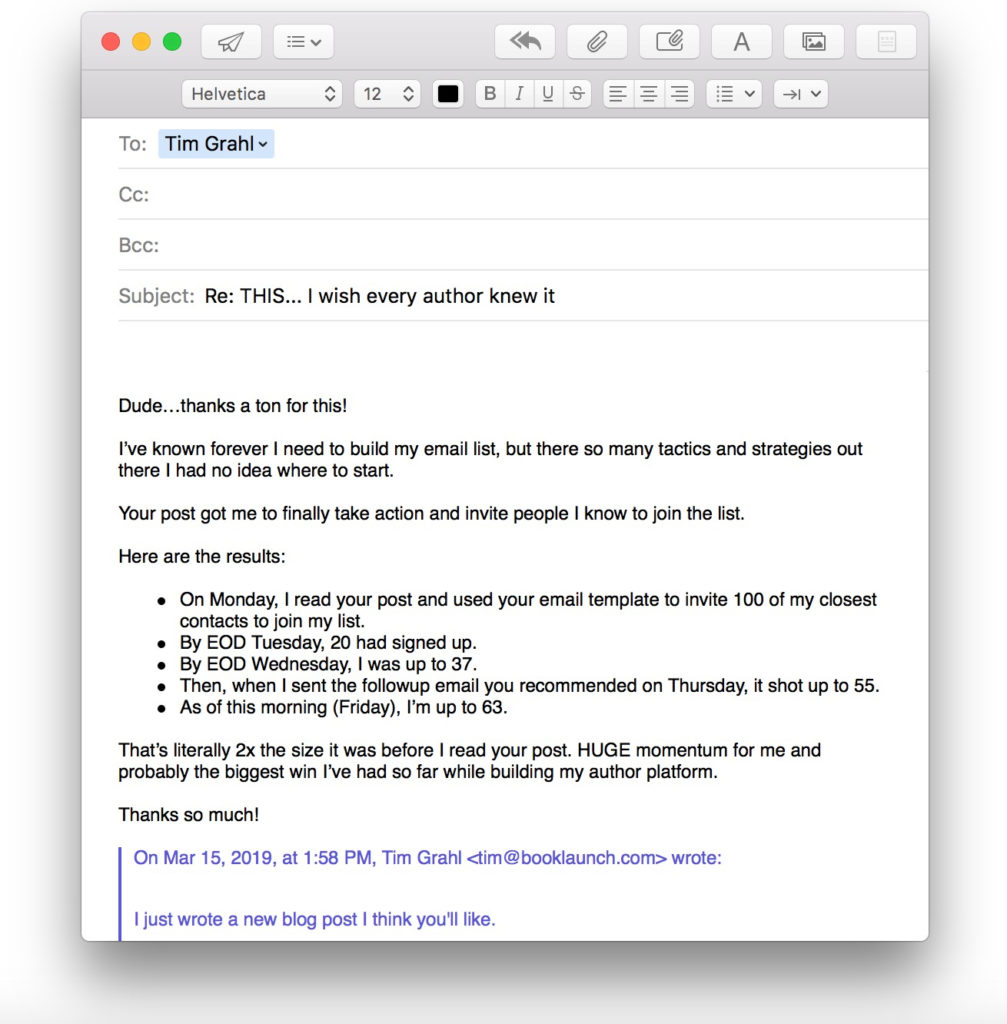
Remember what I said earlier: 99% of the people who email Tim will never actually implement something he teaches before asking him for help.
Which is frustrating.
When you send someone an email like this you are giving them a gift.
Hearing from people who “get it” NEVER gets old, no matter how popular someone has become.
If you’re willing to take action and write an email like this to someone you would love to get guidance from, doors will open that you never knew existed.
They will read it.
They will be grateful.
More often than you might think, they will respond to your email.
And that is your opportunity to unlock a “fast-forward.”
When you get a response, here’s what you do:
- Send a reply as quickly as you can.
- In the reply, acknowledge what the influencer said in their response and thank them for replying. (Don’t just skip right ahead to an ask.)
- Ask them ONE SPECIFIC question related to the challenge you’re currently experiencing.
Don’t be vague. Don’t be broad. Don’t be long-winded.
Ask a direct question about your #1 challenge—you’ll be surprised by how many people are willing to respond with 1:1 feedback once you’ve already shown them you’re willing to take action on their advice.
Fast-Forward Source #2: Clarity.fm
The top 2 excuses I hear from people who can’t find coaching are:
- “I don’t know where to look.”
- “I can’t afford it.”
Clarity.fm is one of the most effective resources I’ve found for obliterating both of those excuses.
What is it?
In a nutshell, it’s a directory of people who are experts in specific topics or areas of business. And for a per-minute rate, you can hop on the phone with them and get their direct feedback/guidance on anything related to their topic.
For example, let’s say you’re building an email list so you can promote a launch you’re running on Kickstarter.
You can go to Clarity.fm and search specifically for Kickstarter experts:
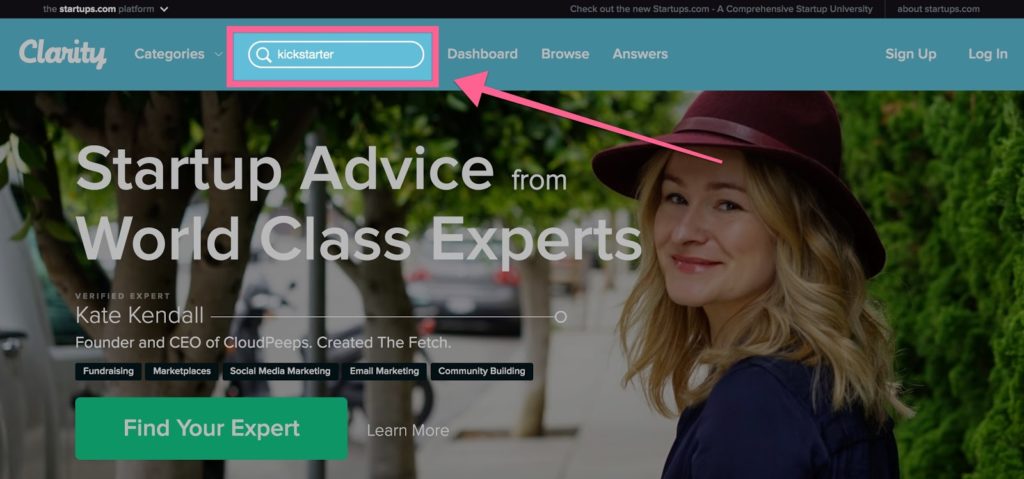
Look at all the people available who are experts in crowdfunding via Kickstarter:
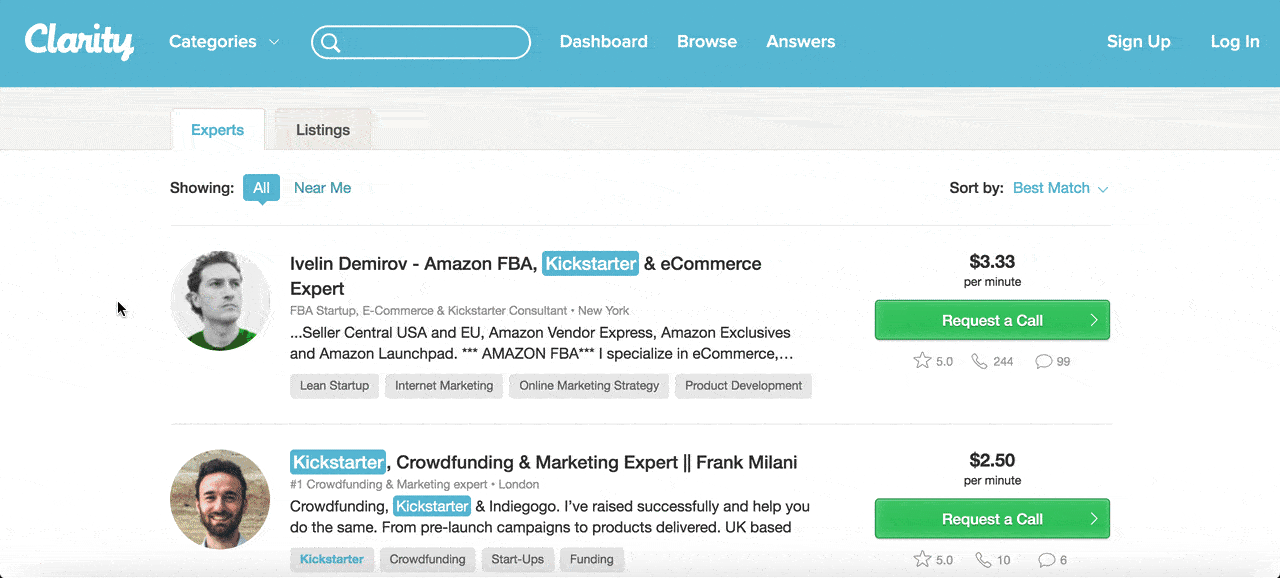
In the top 5 results alone, there’s someone who has raised over $175 million on Kickstarter, someone else who has raised over $900k, and someone who has raised over $50 million.
Do you think a phone call with one of those people might be able to fast-forward your first Kickstarter launch? Like this guy, for example:

For less than $200, you could spend an hour getting specific guidance from someone who’s succeeded again and again at exactly what you’re trying to do.
The cool part is you can even read reviews from people who have already hired the expert you’re considering:
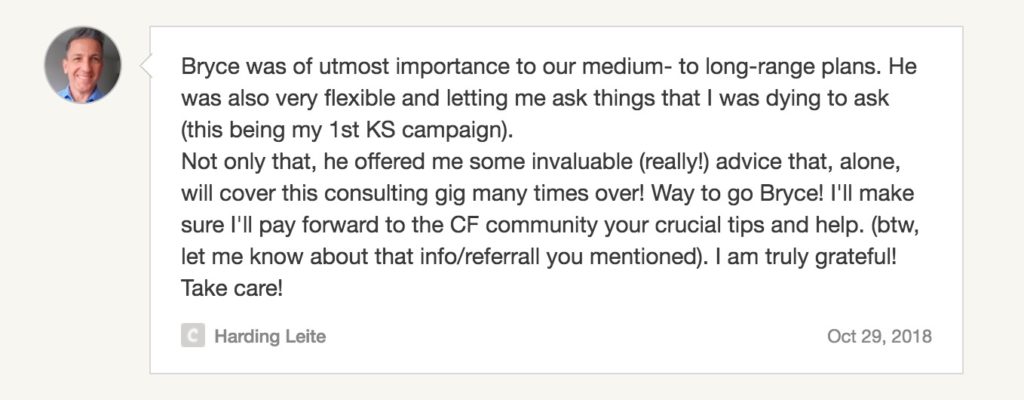
That is the review of someone who just experienced a massive fast-forward.
Regardless of whether you can afford to hire someone for this type of coaching right now or not, I want you to do 3 things real quick:
- Go to Clarity.fm.
- Search for your specific niche/industry.
- Browse through the list of people who come up and imagine what questions you’d ask them.
You don’t have to commit to hiring anyone immediately. But I want you to see the kinds of options that are available, no matter what type of business you’re building—and how affordable many of them are.
Fast-Forward Source #3: Ask your heroes who THEY go to for coaching.
Fast-Forward Sources 1 and 2 are both what I would call “ad hoc coaching”—you have a specific goal/problem/challenge and you find someone who can accelerate your progress on that specific thing.
When you’re starting out building your list and growing your business, those are the kinds of fast-forwards I’ve found to be the most helpful.
But you may eventually get to the point where you want to hire a coach who can meet with you regularly and go deep into broader issues across your business and life.
Once you get to that point, promise me you’ll ignore the conventional wisdom on how to find that person:
“Go to someone whose business and/or life you admire and ask them to coach you!”
This is a nice idea in theory—and sometimes it does work—but more often than not one of the following things happens:
- They say no because they’re too busy to offer coaching.
- They reluctantly agree but end up being a mediocre coach.
The bottom line? If someone isn’t already actively coaching people—and isn’t laser-focused on being a great coach—you’re likely to be disappointed.
It’s freaking hard to help people solve their problems, and it takes a lot of time, energy, and focus. Even though you know someone who built the kind of business you want to have, that doesn’t mean they’re equipped to help you do the same.
So before you ask someone you admire to coach you, try asking them this question instead:
“Who have you hired as a coach?”
(Yeah, yeah, I know it should technically be “Whom” but you’ll sound like a weirdo if you ask it that way.)
Why will this question get you better results? It’s simple:
Solving people’s problems = hard.
Recommending someone who solved YOUR problems = easy.
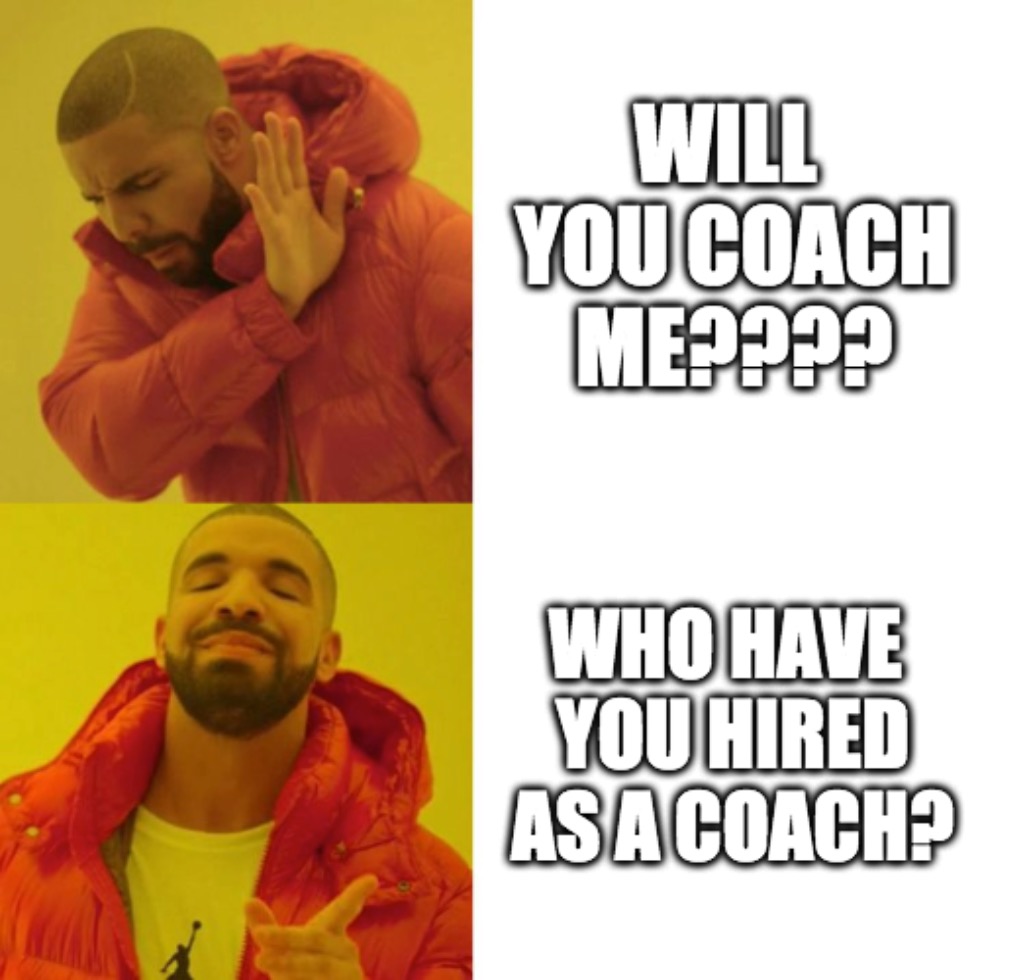
Asking your heroes this question is basically like getting access to their secret weapons.
You’ll get the names of people you didn’t even know existed who have a proven track record of helping people get the results you want to achieve.
And guess what? If the person you ask does offer their own coaching services, they’ll tell you when you ask them this!
It’s a win-win.
Your Action Items:
- Write down ONE challenge you’re going through that you would love to get feedback on.
- Choose 1 of the 3 Fast-Forward Sources listed above that you think could lead you to someone who has already solved that challenge.
- Take the first step associated with the Fast-Forward Source you select.
You’re capable of eventually figuring out 99% of the list-building challenges you’re liable to encounter.
The only question is how long you want to spend trying to solve them on your own.
You don’t have to go it alone.
Fast-Forwards are all around you. But you have to take the first step if you want to unlock them.
Want to Skyrocket Your Revenue Over the Next 90 Days?
Book a complimentary Strategy Call with our team. We’ll look under the hood of your business, identify your best growth opportunities, and show you the action plan for taking advantage of them.
You Have Everything You Need to Add at Least 1,000 Subscribers to Your Email List. What Will You Do With It?
Listen, I know this is a long post.
But it’s not long for the sake of length.
It’s long because it contains the best of what we’ve learned about building an email list after dedicating the past 5+ years to helping businesses of all shapes and sizes do exactly that.
The businesses we’ve seen consistently succeed at building large email lists are the ones that stay focused on executing a simple plan while tuning out all the other distractions.
They don’t get sidetracked by the latest shiny tactic.
They don’t give up when the first strategy they try doesn’t go according to plan.
They don’t continue to aimlessly publish content and just hope subscribers sooner or later discover them.
They follow the 5-part plan I laid out in this post over and over again.
So bookmark this post. Come back to it when you need a fresh idea. Ask questions in the comments if you could use some help.
You have the plan. Now what will you do with it?
Schedule a free call with a Growth Tools coach!
